

Writing historical diary entries based on real journals
by Kim Kautzer | Feb 20, 2017 | High school , Writing Across the Curriculum
Writing historical diary entries is not only a practical writing assignment, but it’s an activity that makes history come alive!
A while back, I talked about how much our family enjoyed using journaling ideas for writing across the curriculum . Even though the journaling tips and examples would work for all ages, they are especially effective with younger children, even pre-readers.
Study Real Historical Journals
For for a project that springboards from actual historical journals —true living books written by men and women who experienced the times—students will be writing historical diary entries of their own.
Because of the more challenging vocabulary found in most old journals, we recommend this activity for high-school aged students . Some mature junior highers with advanced reading skills could do this as well. Take care to guide them toward appropriate sources.
Write Diary Entries
- Historical journals, narratives, and diaries abound, both in books and online. Have your teens read the actual narrative or journal of a person you’re learning about in history.
- Ask them to choose five key events or times in this person’s life.
- Then, in their own words, have them write five diary entries for those pivotal times or incidents. Instruct them to write in the voice of the historical figure, putting themselves in that person’s shoes and writing in first person.
- Each diary entry must include the time and location.
- When the incident is a major historical event, have students highlight the role the person played.
- For context and understanding, instruct them to weave background information into their diary entries.

Find Online Resources for Historical Journals and Diaries
Below you’ll find some links to resources for online journals your teens can use when writing their historical diary entries. To ensure that diary content is age-appropriate for a child, we strongly recommend parent preview or supervision.
Diary File – These digitized diaries make it so much easier for students to read and understand often-illegible journal entries. For added interest, several of the diaries have been written by teens.
The Diary Junction – Internet resource linking to hundreds of historical diaries. Search alphabetically or chronologically
American Slave Narratives: An Online Anthology
First-Person Narratives of the American South
American Journeys: Eyewitness Accounts of Early American Exploration and Settlement – Columbus, Cartier, Sir Frances Drake, Lewis and Clark, many more

Looking for a more structured program to incorporate writing across the curriculum into writing lessons? WriteShop I & II lessons help homeschool teens learn important techniques of writing style and structure while offering flexibility of topics.
Let’s Stay Connected!
Subscribe to our newsletter.

- Gift Guides
- Reluctant or Struggling Writers
- Special Needs Writers
- Brainstorming Help
- Editing & Grading Help
- Encouragement for Moms
- Writing Games & Activities
- Writing for All Subjects
- Essays & Research Papers
- College Prep Writing
- Grammar & Spelling
- Writing Prompts
Recent Posts
- An exciting announcement!
- 10 Stumbling Blocks to Writing in Your Homeschool
- Help kids with learning challenges succeed at homeschool writing
- How to correct writing lessons without criticizing your child

- Walden University
- Faculty Portal
Common Assignments: Journal Entries
Basics of journal entries, related webinar.
Didn't find what you need? Search our website or email us .
Read our website accessibility and accommodation statement .
- Previous Page: Writing a Successful Response to Another's Post
- Next Page: Read the Prompt Carefully
- Office of Student Disability Services
Walden Resources
Departments.
- Academic Residencies
- Academic Skills
- Career Planning and Development
- Customer Care Team
- Field Experience
- Military Services
- Student Success Advising
- Writing Skills
Centers and Offices
- Center for Social Change
- Office of Academic Support and Instructional Services
- Office of Degree Acceleration
- Office of Research and Doctoral Services
- Office of Student Affairs
Student Resources
- Doctoral Writing Assessment
- Form & Style Review
- Quick Answers
- ScholarWorks
- SKIL Courses and Workshops
- Walden Bookstore
- Walden Catalog & Student Handbook
- Student Safety/Title IX
- Legal & Consumer Information
- Website Terms and Conditions
- Cookie Policy
- Accessibility
- Accreditation
- State Authorization
- Net Price Calculator
- Contact Walden
Walden University is a member of Adtalem Global Education, Inc. www.adtalem.com Walden University is certified to operate by SCHEV © 2024 Walden University LLC. All rights reserved.
Historical Journal
Students will create a historical journal from a fictional character's point of view..

“Those who cannot remember the past are condemned to repeat it...” —George Santayana
While we do need to know and remember facts about the past, we more importantly need to think deeply about how events, circumstances, culture, and leaders in the past affect the lives of human beings.
To help students make this connection, skip the traditional research report about a person or event. Instead, ask students to explore primary and secondary sources and create a series of fictional journal entries that share information about the past and indicate how it affected the lives of a specific person living during that time.
Students often view history as a collection of disconnected facts with little, or no, relevance to their current lives. But the study of history provides opportunities to explore issues of leadership, equality, interdependence, movement, which are not only relevant, but important ideas for students to think deeply about in order to grow into concerned and active citizens.
Using journal writing as a learning method in the classroom promotes empathy and aids learners in terms of personal growth, synthesis, reflection on the new information that is acquired, and promotes critical self-reflection when dilemmas, contradictions, and evolving worldviews are questioned or challenged.
Explore a time period or events using primary sources, field trips, discussions, and other activities in your text book or collection of instructional resources. Let students know that they will share their learning about the time period or events you are studying through fictional journal entries.

Take time to explore examples of diaries and journals together. Many students will have already read The Diary of Anne Frank , others may have read or seen the movie, Diary of a Wimpy Kid . Use these experiences to discuss content and writing strategies that make journals interesting to read.
As they work to complete their historical research, ask students to think about the different perspectives of people affected. Have them choose a specific person, or create a fictional character they will use, to share a first-person perspective of that time.
Have students create a list of character traits for this person and create a character analysis focusing on the events they are studying. Students can start with the 5 W’s (who, what, when, where and how), but should also brainstorm ideas and research information that supports their analysis of:
- The character’s actions in response to the outcome an event.
- The character’s emotional state during this time of oppression.
- Effects of the character’s behavior on other individuals (family, friends, community members, etc.) during this time.
- The character’s fears of what might happen if things do not go according to plan.
Once the character analysis is complete, students should begin writing. They should create outlines and rough drafts that include:
- At least three events that take place during this time period,
- Vivid descriptions each of these events,
- Narration of these events from the perspective of their character,
- An interesting hook, and descriptive details, that connect the reader to the character writing the journal.
Students can take these resources and combine them into a rough draft of the journal entries. Have students share their drafts with a peer for feedback and suggestions. Students should then make appropriate edits and changes in their journal entries.
Have students use a publishing tool like Wixie to combine their text with images, music, and narration that will support their journal entries. They may be able to find appropriate images from the collections at the Library of Congress and Pics4Learning.
Have students present their journals to the rest of the class. Invite other teachers or local historians to help evaluate their final products.
Share student writing with other students and community members to help raise awareness about a movement or issue. You can share them in the library by printing the journals or creating an interactive page on your classroom web site that connects to each students work. You may also be able to share student work with a local museum, so patrons can use their personal devices to gain additional perspectives on the materials shared in an exhibition.
To support student progress, conduct formative assessments during the research, writing, and publishing process. Review student research notes, character choice and character analysis to help them clarify thinking and comprehension of the informational texts they are encountering. Listen in on, or collect, peer reviews of their rough drafts.
The final journal entries serve as a fantastic performance task showing research and a student’s skill combining informative and narrative writing. Create a rubric or checklist to help guide student work during research, writing, and publishing.
Landau, Elaine. The Civil Rights Movement in America ISBN-10: 0531187659
Wikipedia – Civil Rights Movements http://bit.ly/eIh6vl
Diary of a Wimpy Kid https://www.funbrain.com/books/diary-of-a-wimpy-kid
Common Core
Standards for the English Language Arts
Write informative/explanatory texts to examine a topic and convey ideas, concepts, and information through the selection, organization, and analysis of relevant content.
Write narratives to develop real or imagined experiences or events using effective technique, relevant descriptive details, and well-structured event sequences.
Draw evidence from literary or informational texts to support analysis, reflection, and research.
National Curriculum Standards for Social Studies
Explain how information and experiences may be interpreted by people from diverse cultural, perspectives and frames of reference.
Analyze and explain the ways groups, societies, and cultures address human needs and concerns.
ISTE NETS for Students 2016:
3. Knowledge Constructor Students critically curate a variety of resources using digital tools to construct knowledge, produce creative artifacts and make meaningful learning experiences for themselves and others. Students:
a. plan and employ effective research strategies to locate information and other resources for their intellectual or creative pursuits.
b. evaluate the accuracy, perspective, credibility and relevance of information, media, data or other resources.
c. curate information from digital resources using a variety of tools and methods to create collections of artifacts that demonstrate meaningful connections or conclusions.
6. Creative Communicator Students communicate clearly and express themselves creatively for a variety of purposes using the platforms, tools, styles, formats and digital media appropriate to their goals. Students:
a. choose the appropriate platforms and tools for meeting the desired objectives of their creation or communication.
b. create original works or responsibly repurpose or remix digital resources into new creations.
d. publish or present content that customizes the message and medium for their intended audiences.
Lessons by Subject
Language Arts
Social Studies
Lessons by Grade
Get the latest from creative educator.
Creative classroom ideas delivered straight to your in box once a month.
Add me to the Creative Educator email list!
- Hero's Journey Lesson Plan
- Infographics Lesson Plan
- Design a Book Cover Lesson Plan
- Informational text projects that build thinking and creativity
- Classroom constitution Lesson Plan
- Set SMART Goals Lesson Plan
- Create a visual poem Lesson Plan
- Simple surveys and great graphs Lesson Plan
- Embrace action research

Political Cartoons Then and Now

Get started with rubrics!

A student's turn to flip

Digital storytelling across the curriculum
More sites to help you find success in your classroom

Share your ideas, imagination, and understanding through writing, art, voice, and video.

Rubric Maker
Create custom rubrics for your classroom.

Pics4Learning
A curated, copyright-friendly image library that is safe and free for education.

Write, record, and illustrate a sentence.

Interactive digital worksheets for grades K-8 to use in Brightspace or Canvas.
Professional Learning

Digital Storytelling
21st Century Classrooms
Project-based Learning
Teaching and Learning
Informational Text
English Language Aquisition
Visual Arts
© 2024 Tech4Learning, Inc | All Rights Reserved | Privacy Policy
© 2024 Tech4Learning, Inc | All Rights Reserved | https://www.thecreativeeducator.com
Historical Diaries & Journals Online
- Vital Records Around the World
- Genealogy Fun
- American History
- African American History
- African History
- Ancient History and Culture
- Asian History
- European History
- Latin American History
- Medieval & Renaissance History
- Military History
- The 20th Century
- Women's History
- Certificate in Genealogical Research, Boston University
- B.A., Carnegie Mellon University
Explore thousands of historical diaries and journals online, by writers from all walks of life. Experience the past lived by your ancestors and other people from history, through personal narratives and writings depicting time, places and events from around the world.
Ella's 1874 Pocket Diary
An 1874 pocket diary from an antique store in Fort Ann, New York, didn't include the name of the author but is rich with other names and stories from her life as a schoolteacher in Vermont. You can also learn more about the author, Ella Burnham, and her family in this genealogical exploration .
The Diary Junction
Browse links and information to over 500 historical diaries online, many to diaries or journals of famous figures, but some written by every-day people as well.
Wisconsin Historical Society - Historic Diaries
Each year the Wisconsin Historical Society posts an original historic diary online, with each day's journal entry posted on the same date as the original entry was written.
Among the online historical diaries available include the handwritten journal of the only member of the Lewis and Clark expedition to die en route, Sgt. Charles Floyd; the 1834 Diary of Presbyterian missionary Cutting Marsh (1800-1873); and the 1863 diary of Emily Quiner, who went South in June 1863 to work in a Civil War hospital for wounded soldiers.
Sallys Diaries
Sally's blog focuses on sharing some of the more interesting and heartfelt entries from her extensive personal collection of "other peoples" diaries, on both this blog and her second blog at sallysdiaries2.wordpress.com .
Wynne's Diary
Winifred Llewhellin, born on 15 June 1879, began writing in a diary at the age of 16 and continued doing so until her death. This extensive online collection includes 30 large volumes that document her daily life in Edwardian England - there are even photographs!
Not all of her diaries are online, but there are currently entries from 13 diaries available covering the time period 1895 to 1919. Navigation is a little confusing so make sure to visit the HELP page as well as click on "More info" for all entries.
Do History - Martha Ballard's Diary Online
This site explores the remarkable eighteenth-century diary of midwife Martha Ballard, with both digitized and transcribed full-text versions of the 1400-page diary; the latter is searchable by keyword and date. It also examines how historian Laurel Thatcher Ulrich pieced together the diary to write her amazing book "A Midwife’s Tale."
First-Person Narratives of the American South
Focused primarily on the words and voices of women, African Americans, laborers, and Indigenous peoples, this site from the University of North Carolina offers a variety of narrative documents, including personal accounts, letters, travelogues, and diaries, relating to the culture of the American south in the late nineteenth and early twentieth centuries.
Prairie Settlement: Nebraska Photographs and Family Letters
Approximately 3,000 pages of family letters, from collections of the Nebraska State Historical Society, describe the trials of establishing a homestead in Nebraska and everyday life on the Great Plains as they follow the Uriah Oblinger family’s sojourns in Indiana, Nebraska, Minnesota, Kansas, and Missouri. Part of the Library of Congress American Memory Project.
Valley of the Shadow
The story of two separate communities -- Chambersburg, Pennsylvania in the North and Staunton, Virginia in the South -- and the political events that encompassed them between 1859 and 1870, are told through this searchable, online collection of more than 600 letters and diaries. From the University of Virginia.
Camping with the Sioux: Fieldwork Diary of Alice Cunningham Fletcher
Alice Fletcher, an unmarried anthropologist, spent six weeks living with the Sioux at the age of 43. Her journals presented online by the National Anthropological Archives, Smithsonian Institution, including sketches and photographs.
Documenting the American South
Look under "D" or search for "diary" to turn up a number of wonderful online historic diaries and journals, including the colorful Diary from Dixie written by Mary Boykin Miller Chestnut, wife of U.S. Senator John Chestnut from South Carolina between 1859 and 1861.
Iowa Digital Library: Civil War Diaries and Letters
Almost 50 digitized Civil War diaries, plus letters, photographs, and other items, tell the story of Iowans during the U.S. Civil War. Don't miss the Civil War Diaries and Letters Transcription Project where you can also search completed transcriptions, or give back by doing some transcribing yourself.
African American Odyssey
This free online collection from the American Memory Project of the Library of Congress includes a number of diaries, such as the emotional Michael Shiner diary, which tells the story of an enslaved man who rescued his wife and three children in 1832 after they were sold to enslavers in Virginia.
The Overland Trail: Emigrant Diaries, Memoirs, Letters & Reports
Explore a collection of over 100 links to diaries, journals, and recollections of individuals describing their journeys west along various migration trails. There's a large emphasis on migration through Oregon, but emigrants through most western states are represented.
BYU: Mormon Missionary Diaries
Read the journals and diaries of 114 LDS missionaries from the collections of BYU's Harold B. Lee library, through both digitized images and searchable text transcripts.
These missionary diaries do include some individuals fairly prominent in the LDS Church, such as James E. Talmage, Moses Thatcher, and Benjamin Cluff; however, most of the 114 missionaries represented were every-day people from all walks of life.
Trails of Hope: Overland Diaries & Letters, 1846–1869
This outstanding digital collection from BYU's Harold B. Lee library includes the original writings of 49 voyagers on the Mormon, California, Oregon, and Montana trails who wrote while traveling on the trail. Accompanying the original diary images and their searchable transcripts are contemporary maps, trail guides, photographs, watercolors and art sketches, and essays on the Mormon and California trails.
- 10 Don't Miss Historical Map Collections Online
- Historic Land Ownership Maps and Atlases Online
- 10 Fabulous Sources for Family History Books Online
- U.S. State Archives Online
- Keeping a Diary
- 5 Things You Don't Know About Anne Frank and Her Diary
- Biography of Anne Frank, Writer of Powerful Wartime Diary
- American Author Maps: Informational Texts in the English Classroom
- What Is Women's History?
- 5 Classic and Heartbreaking Narratives by Enslaved People
- MLA Bibliography or Works Cited
- Ednah Dow Cheney
- FamilySearch Historical Records
- Family Tree Lesson Plans
- Fashion Throughout History
- Top 5 Books About American Writers in Paris
The Role of Journal Writing in Historical Thinking
D. Antonio Cantu | Sep 1, 2000
"I think of writing as a way of seeing. It's a way of bringing out the specialness of ordinary things." —Laurence Yep
Nearly a decade ago, as a high-school history teacher, I was asked to participate in a "writing across the curriculum" grant. I entered the process quite confident in my ability to challenge my students through a variety of thinking and assessment activities that focused on the art of writing. Needless to say, I was very naïve. Once I came to this realization, I was ready to learn. Through my experience in this grant and my interaction with English and literature teachers, I adopted a number of new teaching strategies that focused on student writing.
The format with which I have had the most success is journal writing. For me, journal writing seems an ideal instructional tool for taking students to higher order cognitive learning levels and for achieving many of the affective learning goals I have identified as requisite to deeper understanding. I have also found journal writing to be a very effective means for integrating all of the elements of historical thinking into my curriculum. When I speak of historical thinking, I am referring to the definition outlined in the National Standards for History , which includes the following components:
Chronological Thinking
- Historical Comprehension
- Historical Analysis and Interpretation
- Historical Research Capabilities
- Historical Issues-Analysis and Decision-Making1
I never want to sacrifice content for process, and journal writing does not require that of those who choose to utilize it in the classroom. Another benefit of journal writing for me has been the tremendous flexibility inherent in its design. Journal writing activities can be assigned on a daily, weekly and/or semester basis and can be worked out in various formats: notebooks, index cards, typed documents, 3.5" computer disks, protected/secure web pages, and e-mail messages.
I am well aware that we are all instructional and curricular gatekeepers, and therefore not all teaching and learning activities will see the light of day in our classroom. I would have it no other way. As you examine the various forms of journal writing activities and implementation strategies, however, my hope is that all readers derive some benefit from this discussion, in accordance with the axiom, put forth by the Bradley Commission on History in Schools, that "variety is the spice of learning, just as it is of life."2
Integration Techniques
Journal writing may be integrated into the history curriculum in myriad ways, I will provide an overview framed by the National Standards definition.
1. Text Review Journal
The authors of the National Standards for History call chronological thinking the "heart of historical reasoning."3 One way for students to identify the role and importance of temporal order, historical causation, as well as change and continuity is for history instructors to build this mental scaffolding. The type of journal assignment that appears best suited for this task is a text review. Text review journal writing encourages students to use the chronological timeline in the textbook as a baseline for other primary and secondary source materials they encounter in their readings, research, and class lectures. Students should place the items they come across in these other sources on the timeline. This allows them to establish temporal order and to compare and contrast the varying historical accounts and interpretations they encounter during the course of their research and classroom discussion. For example, students can respond to journal prompts or assignments that ask them to
- identify the temporal order of the text's narrative;
- identify the interpretation of historical causation, events, and individuals in the text;
- compare historical interpretations in the text with those presented in class lectures/discussions;
- compare historical interpretations in the text with those presented in other course readings;
- compare historical interpretations in the text with those presented in research sources;
- place historical individuals, events, and movements encountered in other sources on the chronological timeline presented in the text's narrative; and
- discuss contradictions or inconsistencies between the text's chronological timeline and that of other sources.
2. Dialogue Journal
The Bradley Commission Report on History Teaching argues that one of history's "habits of the mind" is for students to develop an understanding of the "significance of the past to their own lives, both private and public, and to their society." 4 For this to occur, they must develop a degree of historical comprehension necessary to appreciate historical perspectives and avoid present-mindedness. To achieve this goal students must be provided with opportunities to discuss historical issues and general learning concerns. As we all know, some students utilize office hours, those moments before and after class, as well as voice, electronic, and snail mail to address these issues and concerns. Most, however, do not. Dialogue journal writing provides a medium for discussing these issues in a manner integrated into the curriculum. Students might be asked to
- note general observations about course material;
- make suggestions or recommendations that might enhance student understanding;
- identify "lessons learned" thus far, including application to their own life and present society;
- list those lessons or topics they would like to learn more about;
- discuss individual learning progress, both positive and negative features;
- identify learning obstacles, including areas of concern, confusion or misunderstanding; and
- propose possible courses of action to overcome these barriers to learning and understanding.
3. Primary Document Analysis Journal
Analysis, the authors of the National Standards for History argue, "obliges the student to assess the evidence on which the historian has drawn and determine the soundness of interpretations created from that evidence." 5 Such analysis and interpretation is possible only when students are allowed the opportunity to analyze, evaluate, compare, and contrast numerous primary source materials. As noted by some of the authors of the National Standards for History , "innumerable, and memorable, insights are to be gained from longer, closer looks at selected episodes, and all the more so by the deft use of primary sources." 6 Journal writing provides students with a means for recording their observations and conclusions in a comprehensive and systematic manner, thereby bringing a greater degree of consistency and authenticity to the learning process. For example, in their primary document analysis journals, students may be asked to:
- identify the historical context in which the document was written;
- discuss the attitudes, beliefs, and values which are held by the author(s) of the document;
- determine the ideas, principles, beliefs, and values that are reflected in the document;
- identify the impact and legacy of the document, in particular causal relationship with other events or documents;
- compare and contrast historians' interpretations, similar documents, and other historical perspectives; and
- evaluate the role of the document in our nation's history.
4. Research Journal
The authors of the National Standards for History best summarize the sentiments of most history educators by noting that, "perhaps no aspect of historical thinking is as exciting to students or as productive of their growth in historical thinking as 'doing history'." 7 As with the other historical thinking skills, historical inquiry can also benefit from student journal writing, though in a much different manner. Students can benefit at every step of the inquiry process by maintaining a companion research journal, to record their thought and decision making processes. A research journal provides students with a designated space to
- formulate historical questions and a thesis statement;
- list primary and secondary historical data sources;
- evaluate historical source materials; and
- record researcher's reflective thoughts and observations throughout the research process.
5. Classroom Discussion Journal
One of the most engaging forms of journal writing is that which literally takes place in the classroom. When integrated into the history curriculum, classroom discussion journals have the potential to develop what certain architects of the National Standards for History have referred to as "perhaps the surest path to engagement and thereby to acquiring other habits of critical thought and perspective," historical empathy. 8 Well-structured journal writing prompts can spark the type of thought and reflection that allows students to develop both a deeper understanding and historical empathy. Journal writing activities may be introduced at various strategic points in the classroom discussion, including prior to instruction, as a transition technique, to check for student understanding, or as a summary activity. These journal prompts may also be designed to teach a number of historical facts, concepts, themes, or issues, as well as to facilitate the development of a variety of historical thinking skills. For example, classroom journal writing can encourage students to
- identify salient issues relevant to understanding of historical events and movements;
- relate these historical issues to current societal concerns;
- discuss the problems and dilemmas which confronted individuals in history;
- discuss the role of historical context and antecedent circumstances;
- determine the alternative courses of action available to individuals during specific events in history;
- identify the beliefs, attitudes, and values that played a role in the decision making process of individuals in history; and
- evaluate decisions made by individuals in history.
I am well aware there are no panaceas in education. I also recognize, though, that the educational pendulum has a propensity to swing with more ease, velocity, and stride than any other profession, in search of one. What I can attest to, with certainty, is that journal writing has helped my students gain deeper historical understanding and provided them an opportunity to demonstrate their proficiency in the essential skills that comprise historical thinking. While journal writing represents but one pedagogical tool or means to assist in achieving this goal, it is one I recommend.
1. National Center for History in the Schools, National Standards for History: Basic Edition (Los Angeles: National Center for History in the Schools, 1996).
2. Bradley Commission on History in Schools, Building a History Curriculum: Guidelines for Teaching History in Schools (Westlake, Ohio: National Council for History Education, 1995), 24.
3. National Standards for History , 62.
4. Paul Gagnon and the Bradley Commission on History in Schools, eds., Historical Literacy: The Case for History in American Education (Boston: Houghton Mifflin, 1991), 25.
5. National Standards for History , 65.
6. Charlotte Crabtree et al., eds., Lessons From History: Essential Understandings and Historical Perspectives Students Should Acquire (Los Angeles: National Center for History in the Schools, 1992), 18.
7. National Standards for History , 67.
8. Charlotte Crabtree et al., 153.
9. Bradley Commission on History in Schools, 24.
D. Antonio Cantu is assistant professor of history at Ball State University in Muncie, Indiana, where he also serves as editor of the International Journal of Social Education.
Tags: Teaching Resources and Strategies
The American Historical Association welcomes comments in the discussion area below, at AHA Communities , and in letters to the editor . Please read our commenting and letters policy before submitting.
Please read our commenting and letters policy before submitting.

In This Section

Tell Your Story with Evalogue.Life
Everyone has an important story. Tell yours now, and it will be enough.
How to start or boost a journal writing habit

What style of journal writing is best for you? What are the benefits of journaling? For starters, the U.S. Department of Veteran Affairs reports that therapeutic journaling is as effective as other interventions (such as counseling) for trauma. In this article, we’ll walk through several types of journal writing, practical tips for how to write a journal entry, how to start a habit, and some inspiration for why it is worth the effort. As a biographer, writing coach, and journal writing devotee, I’ll share both evidence-based research and some of my own field experience.
First things first, what is journal writing?
The broadest definition of journaling is simply an informal practice of writing thoughts, feelings, and ideas. There are several types of journal writing with different purposes in mind. By the end of this article, you will be clear on your purpose and can choose the best journaling style for your needs.
Related article: Writing a personal history and why it’s important
Which type of journaling suits you?
Here are several types of journaling at a glance:
- Diary writing in the style of a regular log
- Diary writing in the style of recording important moments/thoughts
- Morning pages
- Writing a personal history
- Therapeutic journaling
Six benefits of journaling
Journaling is advocated by many therapists, physicians, writing coaches, and even the U.S. Department of Veteran Affairs. Here are a few reasons it is worth figuring out a method that works for you.
Benefit #1 – Journaling improves writing skills & creativity
Your writing will improve the more you do it. In the words of Stephen King from his wonderful book On Writing, a Memoir of the Craft, “If you want to be a writer, you must do two things above all others; read a lot and write a lot.” A habit of journaling will keep you limber so ideas can flow from your creative mind onto the page. (Disclosure if you purchase a book using a link in this article we make a small commission from Amazon. It’s a tiny portion of our income, but we always appreciate it)
Related article: My favorite books on the craft of writing
Journalling is often my first stab at a new idea, and this is where I sketch emerging thoughts. My journal entries are precursors to more formal written pieces (or even business plans) to come later. Sometimes, journaling helps me noodle on bad ideas and discard them before they chew up resources.
In short, journaling is a wonderful catalyst that will boost creativity. This habit will invite the muse and clear your mind so you’re ready to work. You might be surprised by what shows up on the page.

Benefit #2 – Journaling helps you figure out what you think
Countless famous authors have said variations on this quote: “I write to figure out what I think.” If you are a writer by nature, then putting words on the page is how you read the world. Journaling is a low-pressure way to process problems and creative ideas. If you hope for this benefit, I especially recommend that you check out morning pages as a style of journaling.
Benefit #3 – Journaling can quiet the swirl in your head
No good comes of letting life’s thorny issues swirl in an amorphous loop inside your own head. Get it out of there and into the light so you can deal with it. Once on the page, clarity often emerges, and fears have a way of becoming manageable. That’s how I do it anyway. Research supports this approach too, so keep reading.
Benefit #4 – Private writing might just save your relationships
There is a time to speak your piece and a time to hold your tongue. Before lashing out at someone you love, try journaling your thoughts instead. Maybe once it’s down on paper you can burn it without torching your relationship. Processing your frustrations will help you proceed more deliberately and with sensitivity. A journal can be a place to dump some icky feelings, get your heart in the right place, and work out what you want to say in a thoughtful way. Write your thoughts, then let them cool before charging into an important conversation.
Related notes: I discuss a practical framework in my course entitled, “ Sensitive subjects, writing about the hard stuff .” Also check out the classic book, Crucial Conversations, Tools for Talking When the Stakes are High .
Watch my tutorial on sensitive subjects (YouTube)
Benefit #5 – Journaling can log your personal history
Diary writing can record details of daily happenings and thoughts, memorializing important dates and events. In addition to just the high points, you may also want to record more thoughtful impressions of those experiences.
Some diarists stick to the facts, and there is nothing wrong with that. Case in point, I do a lot of historic work from the 19th Century and journals are an absolute treasure even when they are brief. Pioneer companies in the U.S. assigned people to journal the trek west and these logs provide glimpses into daily life that reflect the experience of everyone in the wagon train. These journals were generally not works of art, but they served an important purpose and I am so grateful for them. Once in a while, however, I’ll come across a more creative writer and I savor these entries and their rich descriptions.
In your own life, this type of writing will enable you to remember details in the future. This is important because memory is notoriously unreliable, and you’ll be surprised years later to see that your journal affirms or contradicts how you have recalled events. You may even find that you recorded details that meant little at the time but that became important later. In summary, if you have any intention of writing a life story later, even a brief diary log will pay big dividends down the road.
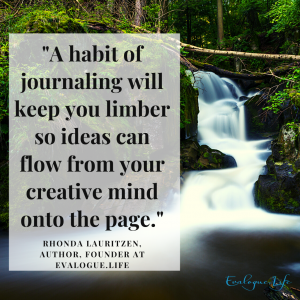
Benefit #6 – Therapeutic journaling is effective & doesn’t burn out your friends
If you are dealing with some tough stuff, then processing thorny issues through therapeutic journaling can be a wonderful alternative or addition to therapy. Doing some diligent journaling on your own can greatly speed up and improve the benefits of formal therapy. This has become an evidence-based treatment in a clinical setting.
In a similar spirit, much like there is a cost to therapy, there is also a cost to venting to your loved ones. Simply put, there’s only so much they can take. Hence, I use informal journaling to process what is bugging me and deal with it at a low level before I’m ready to discuss with anyone else. In doing so, I can sort out most of the garbage before dumping it on people whose relationship I value. I can’t afford to burn out the people who are here for me by venting too much, especially if I’m not ready to take action yet.
Related: Course on sensitive subjects and writing about the hard stuff
Therapeutic journaling can be a structured process, and the most widely used method is called the Therapeutic Writing Protocol, developed by Dr. James Pennebaker.
The U.S. Department of Veteran Affairs says: “Therapeutic journaling can be done by keeping a regular journal to write about events that bring up anger, grief, anxiety, or joy that occur in daily life. It can also be used more therapeutically to deal with specific upsetting, stressful, or traumatic life events.” This protocol works by asking someone to write about a stressful or traumatic emotional experience for 3-5 sessions over several consecutive days for 15-20 minutes per session.
How to write a journal entry using the “Therapeutic Writing Protocol”
- Write for 3-5 consecutive days for 15-20 minutes per day.
- Don’t stop until the time is up.
- Write for yourself and no one else.
- If something feels too upsetting then set that topic aside for now.
- Know that it is common for people to feel somewhat saddened or depressed, especially on the first day or two. This is normal.
- Don’t keep writing about the same topic after many days. If you are not making progress then stop and seek a health care practitioner.
- If the exercise evokes strong feelings that are beyond what you can cope with, stop immediately and reach out to a friend, do breathing exercises, go for a walk, or do some other activity to calm yourself.
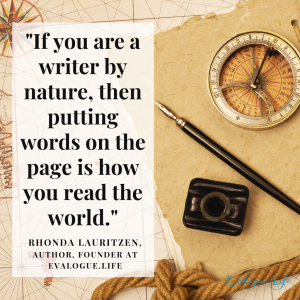
How effective is therapeutic journaling?
The VA adds: “Over the past 25 years, a growing body of research has demonstrated the beneficial effects that writing about traumatic or stressful events has on physical and emotional health.” Therapeutic journaling is associated with both short-term improvements and long-term decreases in health problems such as immune system functioning. People who are going through health problems, breakups, grief, natural disasters, and unemployment have all been shown to have “significant and substantial short-term reductions in post-traumatic stress and depressive symptoms.”
Further, therapeutic writing has been shown to be just as effective as trauma-focused cognitive behavioral therapy, which can be time-consuming and expensive. It is considered an evidence-based treatment. The VA says that “Therapeutic journaling can also be a way to reach people who are unwilling or unable to engage in psychotherapy.”
What’s the difference between a journal and a life story?
A journal, diary, or morning pages are ways of doing informal writing primarily for yourself . In contrast, a life story, autobiography, memoir, or other personal history are written to benefit the reader. A life story has been crafted with care and editing. Ideally, the important moments have been curated and then polished up so they are both engaging and inspiring.
A life story is not a dump of your entire archive; work has been done by an author so the stories will be easy to digest and meaningful. Ideally, an autobiography story will employ techniques of strong story structure so it is fun to read.
In short, journals can be helpful reference material during the research and writing phase of a full life story. They are not the ideal end product. (I can’t imagine someone having to wade through the tedium of my journals.) Caution: If you are writing a life story, be judicious in publishing excerpts from journal entries or risk boring the reader.
Related article: Writing a personal history, journal ideas, and why it’s important
Printable Storyboard Template

Storyboard any book, memoir, biography, or family history tale with our free printable template. It just might save your story.
Success! Now check your email for our printable storyboard template.
There was an error submitting your subscription. Please try again.
How to write a journal entry in the style of morning pages
If your primary goal is to capture a log of important dates, events, and thoughts, you don’t need a complex system. A simple log or notes in a planner or on a calendar will do like we have discussed above. Even social media entries can serve this purpose.
If you’re looking to boost creativity and process your thoughts, however, you might benefit from the prescriptive discipline called morning pages. Many creative types (and even businesspeople) swear by this popular method pioneered by Julia Cameron in her bestselling book The Artist’s Way , first published in 1992. The basic idea is that you write exactly three full pages of longhand, stream-of-consciousness musings in an 8.5” x 11” notebook, as soon as you wake up.
Cameron recommends throwing them away, which increases authenticity and frees you from fears of judgment. What you write is totally up to you, but Cameron is very prescriptive about how . You must do it every day whether you feel like it or not and the length is important too, exactly three pages. If you’re interested in learning more about this type of journal writing, check out her book or do a simple search for morning pages. There are a lot of great articles on the subject.
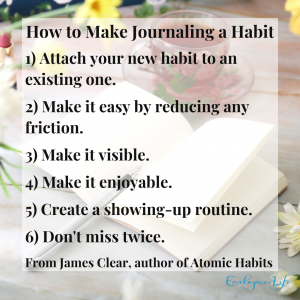
How to start a journaling habit
If you are looking to start a journaling habit, I can’t recommend the book Atomic Habits enough, by author James Clear. He teaches the most current psychology and tips for starting and sticking with any habit. Here are some quick ideas:
- Attach your new habit to an existing one. For example, “While I drink my morning cup of coffee, I will write in my journal.” Clear calls this technique “habit stacking.”
- Make it easy by reducing any friction . This means you need to find a journal writing habit that works for you, whether that’s typing, audio, or into an app that is with you all the time. The more complicated and ambitious, the more likely it will be to fail.
- Make it visible. If you want to start a habit, make sure you SEE the trigger. Set your journal next to your coffee machine, or on your desk first thing in the morning.
- Make it enjoyable. Whatever you need to do to increase the intrinsic rewards will improve your odds of sticking with a habit.
- Create a showing up routine. Create a routine whereby all you do is get started. Just journal for two minutes. If you’re doing morning pages then do it for three pages. Journal whether you feel like it or not because the trick is being consistent. Just get started.
- Don’t miss twice. If life gets in the way you can be gentle with yourself, but the rule of thumb is to never skip your habit more than once.
What format should your journal be? Longhand or typed? Fancy leather or spiral notebook?
I mentioned earlier that I’ve been a lifelong journaler and I have tried many methods. Hence, I have some thoughts on this topic. Of course, the important thing is that you figure out what works for YOU. Overall, keep your method as simple as possible.
If you are doing morning pages, it’s straightforward. See the section above. I’ve had some super fancy leather journals through the years and now eschew them because they are mostly empty. Why? It’s the perfectionism thing. If I think the book is expensive, I feel like what I write should be important and written for posterity. When I write in a book like this, my prose is stilted and pretentious. When I go back and read these entries, they seem constipated as though I was worried I might soil the pretty pages. Hence, I’ve decided that journaling is for me and anything worthy of a leather-bound book will be edited and written into more formal stories for sharing in a different format.
Here’s the happy medium I now utilize for my own journal writing: a combination of audio journals which I substitute for morning pages (because I’m a rebel like that) and journal books I purchase in bulk to keep the price at around $5 each. Here are two options, one 5-pack that I have purchased multiple times, and a 10-pack I just found to get the price down on each journal.
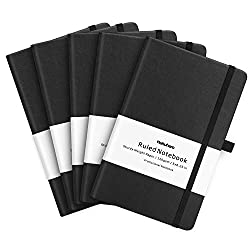
I label the spine of the black journals with a silver sharpie. Hence, I usually have several of these on my desk at any given time. I grab the right one whenever I’m sketching the day’s notes or ideas, depending on what I am working on, during my workweek. These are nice enough that I take at least a little care to make them legible and to organize my thoughts, but they’re basically disposable so I don’t feel like they have to be perfect. These have been worth every penny in formalizing my journal writing habit because they have made it easy, visible, and enjoyable (I like the tactile feel of the paper).
Why not type my journals? Sometimes I do type a longer journal entry when there’s something I really want to say. In theory, this might be the best way overall but in practice, I’ve gone away from typing my journals. That is because I have to sit at my desk to make a living. The computer, therefore, means work and it means being tethered to a screen. In contrast, I want my journaling habit to feel creative and enjoyable. I want it to feel like self-care and not like something I HAVE to do. As I mentioned above, I enjoy the tactile feel of these nice books, and the sound of a pen scratching on paper. I like the indulgence of sitting on the couch to sketch instead of being tied to the chair. Doing audio journals while I am driving or walking also boosts my pleasure as I journal. (See section on habits: make it enjoyable).
Related article: How to transcribe audio

Journaling apps and audio
There are some great apps out there for journaling. I don’t personally use any journaling apps, but I have students who swear by them. Since apps change regularly, I’m not going to review them here. Just know that there are some good ones out there.
I do, however, regularly record audio journals and I use a voice recording app for this. (I currently use the Easy Voice Recorder for Android). Check out our review of voice recording apps by clicking here . I use a Sennheiser headset microphone to isolate background noise and save my voice. When I have a journal entry I want to save, I run the audio through a transcription program . My go-to for transcribing my audio is currently Happy Scribe but there are a lot of good options out there these days.
Related article: The best affordable microphones we have tried
What should you do with your journals?
Word to the wise: If you keep unfiltered journals, someone WILL eventually read them. When they do, there may be very hurt feelings and it will be too late to take it back.
I’ve also had clients inherit journals and say, “I’m not sure I should be reading these.” They wondered if they should share them, but an inner whispered that it wasn’t such a good idea. There was wisdom in that voice. Rather than inheriting a treasure, these people became the unwitting recipient of a burden, like becoming responsible for someone’s debts or baggage. Even if the content was not excessively private, sometimes the sheer volume of a journal collection can overwhelm the recipient. Don’t do this to your heirs.
In my classes, I teach that we ought to send love letters to the future, not ugliness. Yes, it is very important to be real about the hard things we faced , but we must do so after some processing and editing. In writing a life story, we want to understand a character’s back story and then show how life’s challenges helped the hero to grow. We should write with an eye toward triumph.
Related video: When not to share the hard stuff
Are you sending a time capsule or a time bomb into the future? Rhonda Lauritzen, instructor of “Sensitive Subjects, Writing About The Hard Stuff”
If you plan to write a life story, then refer back to journals to jog your memory, but then edit the final product into something that will inspire the reader . Use excerpts from journals judiciously in a life story, otherwise, the reader will be bored. Your original journals were written for your own benefit, but your life story is for the reader.
Hence, it is important that YOU decide what you want to be done with your journals in advance. Then leave some instructions. If they are not to be shared, then make sure you destroy them yourself or install a password and leave instructions that they’re not meant for other people’s consumption. Even if you leave a note to burn them, the recipient probably won’t have the heart to do it. Think I am joking? I have personally destroyed journals. It pained me to do so, but some words don’t need to be memorialized.

Transcribing journal entries
If you need to type up your own or someone else’s journals, save yourself some serious time by transcribing them using speech-to-text technology. Simply read the entries aloud into a speech recognition program. I use this method anytime I have to manually transcribe a letter or historic document.
Here’s a super short video demonstrating how I do this: https://youtu.be/Y2x2LWIZ0Nw
Here are some great journal prompts to get you started:
Here at Evalogue.Life we have a few popular resources for great question prompts.
- The first is a booklet of the favorite interview questions that we use in our oral history interviews. These questions also make great journal prompts. You can purchase these booklets on Amazon by clicking here .
- We also have a comprehensive page with many question prompts here on our site. Click here.
- Download a one-page printable of some all-time favorite questions that everyone should ask:
Questions Everyone Should Ask

Don't have regrets. Preserve a life story now with our all-time best questions. Interview a loved one or prompt your own personal history. Do it now, and it will be enough.
Success! Now check your email for our favorite questions to ask.
Here is a handful of journal writing prompts specifically with journaling in mind:
- What is your biggest struggle right now?
- Gratitude writing: What are you most grateful for? Free write as much as you can think of.
- Describe a typical day in your life right now
- What music are you listening to at the moment? What songs, smells, foods, and pop culture might take you back to this phase in your life if you remember them later?
- What are your feelings about current events? Politics? Pop culture? Fashion?
- Are there children in your life right now? Describe memories you have made recently together. What is this child’s personality like at this age? What does he/she say or do? What are your feelings toward this child? Your hopes for their future?
- Describe what would be a perfect day for you.
- What did you do on your last vacation? Who was there? Describe something that went wrong that you can laugh about now. What was the high point?
- What is a big decision you face right now? Try this exercise (even if it’s just a mental exercise). Flip a coin and say you’re going with whatever the coin toss is. In the moment before you look at the answer, what do you hope the answer is? Some people say that is what you should do. Write down your feelings about this exercise. Draw a line down the middle of the page and write pros on the left, cons on the right. Which side is weighted more heavily?
Try this journal writing exercise when facing challenges
If the purpose of your journal is to process something difficult, try these prompts, thinking of your life as a movie:
- What is the hardest thing you’ve ever lived through?
- In what ways did a traumatic event make life even harder? In what ways did something hard end up shaping you for the better?
- If you could turn back the clock and make it so that event never happened, would you? Why or why not? What would you change? Were there any ways in which this event turned into something beautiful or good? (Note: It’s okay if the answer is no. There isn’t always an upside).
- If you were to write a perfect ending for your life in relation to this event, what would that look like? Use your imagination to create an ending in which a changed character emerges healed and strong. Focus on lessons learned, healing, forgiveness, and triumph.
- What loose ends still remain? What amends still need to be made?
- What did this experience teach you?
Related article: Story endings – the transformative power of storytelling

Rhonda Lauritzen is the founder and an author at Evalogue.Life – Tell Your Stor y . Rhonda lives to hear and write about people’s lives. She believes that when you tell your story, it changes the ending . She and her husband Milan restored an 1890 Victorian in Ogden. She especially enjoys unplugging in nature. Check out her books: How to Storyboard , and Every Essential Element . Most recently she was the writing coach of bestselling author, Rob A. Gentile, who wrote Quarks of Light, A Near-Death Experience: What I Saw That Opened My Heart
- ← Loss, Struggles, Holidays and Making Sense of it all
- What can you learn from a contrarian? →
How to Write a Journal: 6 Tips to Get Started
by Pamela Hodges | 61 comments
Writers are collectors of ideas, and where do we keep them? On scraps of paper, napkins, the notes app of our phones, and sometimes in journals. But as anyone who's started a journal can attest, sometimes it's hard to begin and even harder to keep one going. So how to write a journal? What to write in a journal? Let's look at some simple ways to start capturing ideas.

There are a number of ways to capture ideas, from keeping a gratitude journal, to a reading journal, to a project journal. No matter what type of journal you keep, let me share with you some tips from my journaling experience for how to keep a journal and why a journaling habit pays off for writers.
4 Advantages of Keeping a Journal
Julia Cameron, acclaimed author of The Artist's Way and more recently a 6-week program outlined in a book called Write for Life, begins the writing and artistic life with a practice she calls morning pages. In essence, she suggests writing three pages each morning to explore ideas and life, and to clear the mind.
The benefits of journaling this way are numerous. Writers who establish regular journaling time may find it helps them clear their minds and explore new ideas.
There are many reasons why it is a good idea to keep a journal. I want to share four big reasons this daily habit may help you with your writing process and develop your writing skills.
1. Remember details
When I traveled to Europe in 1978, I kept a journal of my daily life. I have notes from the trip to Greece where I wiped out on a moped, weeded sugar beets on Kibbutz Reshafim in Israel, and hitchhiked through occupied territory in the south of Israel.
There were several details of my trip that I had completely forgotten until I re-read my personal journals.
Recording the details of your life can enrich your stories. One year when for The Spring Writing Contest at The Write Practice, I wrote a story about when the IRS called me to say I owed money.
In my first draft, I wrote that the amount they said I owed was, $638. After I had completed the first draft I went back to the notes I had written in my journal, and the correct amount was over six thousand dollars: $6,846.48 to be exact. Well, maybe there are some things we don't want to remember.
Thankfully, I didn't send the money. It wasn't the real IRS. But it was even better than a writing prompt for a story idea.
2. Find old friends
Keeping a journal can help you find old friends. One of the women I met on November 26th, 1978, wrote down her address. I found her on Facebook and just sent her a message. (Social media and Google can also help, but the journal did remind me of her name.)
We'll see if she responds to my Facebook message. It has been almost forty years since she lent me a pair of gloves when I scraped my hand on the pavement when I fell off my moped.
3. Help process feelings and ideas
When you keep thoughts in your head it can be hard to know how you think and feel. Writing down how you feel will help you process your emotions , as feelings become words, which can be then be edited.
Processing your feelings and ideas can lead to personal growth and peace, but that's not all. Expressive writing can be therapeutic, but it can also help you flesh out characters later.
4. Preserve the writer's history
When you are dead and a famous writer, your journals will give your readers insight into your life, thoughts, and process.
You may never sell more than one hundred copies of your book, you may never publish your writing, or your journals may only be read by the mice that crawl through your basement. Or your journals will be read by zombies after the zombie apocalypse, sharing insight into your life and daily routines.
If you don't want anyone to read your journal, keep it in a locked box and swallow the key. (Please don't really swallow the key. It would be unpleasant to have to find it again, and you might choke.) Put the key in a safe spot, and then remember where you put it.
6 Tips for How to Keep a Journal (and What to Write in a Journal!)
Now you know why journaling can be helpful. But how should you journal? It is very personal, and you should do what works best for you. But I will give you some tips to help you get started on a journaling practice.
1. Choose your kind of journal
You have several options for how to keep your journal.
A book, where you write with a pen or pencil onto paper: Write in a book that is not so pretty you are afraid to write in it. Keep the size small enough you don't mind carrying it in your messenger bag, and big enough you can read your handwriting. Do not try journaling at night when the only paper you have on your bedside table is a bandaid. The next morning I couldn't read my writing on the band-aid, and the idea I wanted to journal was lost.
The advantage of pen to paper is you can write without having to be plugged into an electronic device. You don’t have to worry about a dead battery, and you can write even when the sun is bright or the airline makes you turn off your electronic devices.
The disadvantage to a paper journal is if you lose the journal and you didn’t make a copy of it, you have lost all of the writing. But either way, the journal writing helps you pay attention and record the moments of everyday life that will fade with time otherwise.
Software: There are several software applications and journaling apps on the market you can use to keep a digital journal. Be sure they sync to the cloud, as you don’t want to lose your entries because you fry your computer's hard-drive.
Journey and Day One can add photographs and text, and export all of your entries into a PDF. You can also journal in Google Docs, Microsoft Word, or Scrivener and save your files to a cloud-based program that will keep your files safe if you lose your computer or pour water on your keyboard.
2. Date your entry
You think you will remember when it happened, but without a written date, you might forget. Make it a part of your journal writing routine to date the entry.
3. Tell the truth
The journal is a record of how you felt and what you did. Telling the truth will make you a reliable storyteller.
If you haven’t cleaned the seven litter boxes for a week, don’t write that you clean them every day simply because you want your readers one hundred years from now to think you had good habits. The beauty of journal writing is that you can record things honestly for yourself that you might not otherwise record or share.
4. Write down details
Record details like the time, location, who you were with, and what you were wearing. Details will help bring the memory alive when you record using your five senses .
To this day, if I smell a certain kind of Japanese soup, I can remember vividly the day I flew to Korea to renew my Japanese visa, only to discover the Japanese embassy was closed for a traditional Japanese holiday.
5. Write down what you felt
What you were thinking? Were you mad? Sad? Happy? Write down why.
6. Write a lot or a little
A journal entry doesn’t have to be three pages long. It can be a few words that describe what happened, a few sentences about the highlight of your day, or it can be a short description of an event from your day, where you describe details to help you remember what happened. What time of day was it? What sound do you remember?
Your journal entry might be a drawing, a poem, or a list of words or cities you drove through. It is your journal, and you have the freedom to be creative.
You can use journal writing prompts or simply tap into a memory that floats into your mind.
Bonus tip: How to write a journal entry
Aside from the date, you can write your journal entry in a number of ways. You can write stream-of-consciousness, try bullet points written rapid fire, you can use various art materials, or any form that speaks to you. Try a list or a mix of writing and doodling, or even dialogue exchanges.
The most important thing is just to take the journaling time and make a regular habit of it, even if it isn't on a daily basis. The words will show up when you do.
When to Journal
There is no right or wrong time to write in a journal. Write when you will remember to do it. Do you always brush your teeth before you go to bed? Have writing in your journal be part of your bedtime routine. Perhaps put it on your bedside table, or beside your hammock, or on the floor beside your futon.
If you are a morning person, consider keeping your journal on the table where you drink your morning coffee, tea, water, milk, or orange juice.
These are only suggestions. You don’t have to write down your feelings or why you felt a certain way. I hate being told what to do. Even if it is a good idea. But I hope you'll give it a try and see if you find it unlocks your own writing.
Do you write in a journal? Why is keeping a journal a valuable practice? Please tell us in the comment s.
Do you write in a journal? Do you think writing in a journal is a good idea for a writer, or a bad idea? Please tell us why in the comments .
Write for fifteen minutes about some aspect of your day as though you were writing in a journal. Your journal entry might be a drawing, a poem, a list of words, or a list of cities you drove through.
Please share your writing in the Pro Practice Workshop here and leave feedback on someone else’s practice today. We learn by writing and by reading.
Pamela Hodges
Pamela writes stories about art and creativity to help you become the artist you were meant to be. She would love to meet you at pamelahodges.com .

61 Comments
I found writing a journal to be a learning experience in itself. When I started, I soon realised I didn’t really know what I was trying to achieve. It seems obvious now but I had to keep at it a while for that to become apparent. Everyone has to find their personal journalling style. A few pointers certainly help, so thanks for your post. I completely agree about the sensory aspect. It’s not the result of a to-do list we’re writing, it’s shades of what gave meaning to our day.
Hello Saul Marchant, I love your description, “shades of what gave meaning to our day.” So, not just a list, but what has meaning. Best, xo Pamela
I also like your “shades of what gave meaning to our day.” Sometimes I find myself lamenting that I want more meaning in my activities—as evidenced by my journal entry above. I need to remember that the purpose and the meaning come from my perspective of the experiences, in all the various colors and shades. Thank you.
I agree with Pamela I to love your description “shades of what gave meaning to our day. I think I fall more into a listing journalistic style but time has lead me to include more meaning as I progress.
Pamela, Thank you for a great article on journaling. I started out writing a diary when I was twelve years old, then moved into journaling as an adult, which I did for twenty years, and dropped off for about five years. I renewed my journaling practice in September 2002 and began daily journaling shortly after that. I record the date and time of the entry and number my pages. I am now on page 6515 (since 2002). Some days I journal just a paragraph—other days, I write up to ten pages. It depends on what is happening in my life, and how I am feeling. The time of day and my energy level also play a part—sometimes, I am too tired to write much, but I arrange my day so that I journal every day. I am in the process of reading previous entries and harvesting them for prompts for my fiction writing and blog posts. The depth and wisdom of some of my entries amaze me. Journaling enriches my life and allows me to process my feelings and emotions which contribute to my well-being.
Hello Billie L Wade, Thank you for sharing your journaling experience. I love the idea of numbering the pages. I regret not keeping a journal when I lived in Tokyo, I have some of my letters a friend saved, but there is so much I don’t remember. Would you like to share a short excerpt from when you were twelve, or something more recent, in the comment section on The Write Practice? xo Pamela
Hi Pamela. Unfortunately, I no longer have my journaling prior to 2002 (long stories). The following entry is indicative of a frequent experience with me in which I start out with with a challenge, problem, or issue and come to some resolution by the end of the session. This entry spans pages 6447-6449. This is not edited except to remove names of people. Thank You.
Monday, 3/20/17, 9:38 p.m. I’ve been afraid I’ll die before I’m ready, before I feel fulfilled, before I’ve done what I want to do, before I’m successful, before I’m “self-actualized,” before I’m joyous. At the same time, I hear of young people—22, 35, 38—with plans and futures and young children, dying of cancer and strokes. I’m 67. I’ve lived to see my son grow into adulthood. Really puts things into perspective. I’m not financially wealthy, but I have enough—my bills are paid; I have life, car, renters, health, and supplemental insurance; I have food; I enjoy dining out with friends; I can afford my medications; I have a car; I have books and magazines to read; I can think and feel and love; I can see and hear; I have my natural teeth; I have a new cell phone; I have leather-bound journals and hand-crafted pens; I drink bottled water that is delivered to me; I live in a beautiful apartment with a nice, green view; if I’m frugal, I can afford a few extras each month. I have people in my life who care about me; by many standards, I’ve had three successful careers, I’m educated and articulate; I can taste and smell and feel the sensuousness of touch; I can write; I have challenging projects to work on; I have a therapist who “gets” me and respects me; I have [my family]. The future is uncertain—always has been—and I sometimes feel frightened when I hear the prospects. I read an article within the past few days in which the author wrote something similar to “our acceptance and behavior in the present moment are predictors of our future.” When I am joyful and grateful and fully alive in the present moment, I have a better chance that I will do so in the future. The more I cultivate an attitude of gratitude, faith, and hope today, the more likely I will feel those attitudes in the future. And, how great it would be to die as [my partner] did—with joyful anticipation and expectancy; with gratitude; with hope; in peace. I can feel fulfilled every day by bringing acceptance and awareness and appreciation to everything I do.
…exquisite … and inspiring
thank you for your gift of words and reflection
Thank you Susan.
I started keeping a journal in the third grade, after reading “Harriet the Spy.” I have a drawer full of them, dated and numbered, and I get them out to browse whenever I’m working on a kids story or something YA. It’s a great resource for me to be able to see how a twelve year old mind worked. I’m so glad I kept them. My five year old keeps a drawing journal of the things he sees during the week, which I hope will eventually grow into something he does for a lifetime.
Hello Amanda Niehaus-Hard, Wow! How exciting to have writing from when you were twelve. I am happy you kept them too. What a treasure. A drawing journal is a great idea, a way to journal for children who might not be writing yet. If you would like to, please share a short excerpt from one of your third grade journals with the date, and/or one of your child’s drawing, if they don’t mind. All my best, xo Pamela
Hi Amanda, I am impressed that you have your journaling from age twelve, organized so you can easily use them. Everything I wrote before 2002 was destroyed, and I miss not having all of my writing. I am glad you can use your journaling to inform what you are writing now. Happy writing to you.
Hi, I did not want to do it this way, but this is regarding my guest post submission idea that I proposed on 31st March. I got the email of confirmation from the automatic mailing system, but did not recieve any manual response for the idea that I had submitted. What has brought me here today is that just six days later, a guest post was published on this very website titled “Show, Don’t Tell : How to Inject Drama Into Your Writing.” This did not seem to be a coincidence, since when I read the article, most of it seemed to be derived from the idea that I had proposed to you, and got no response to. I wrote another email, and that too has not recieved a reply regarding the state of my query. I know that this is not how this matter is appropriately resolved, but since I have got no response from your side, I am becoming both ancious and disappointed. The publication of the guest post resembling my idea might have been a coincidence, albeit a strange one. But the fact that I have recieved no response troubles me. All of us are writers here, and I think that beyond a moment of doubt, all of us would agree that it isn’t in the best interest of the art of writing and all the virtues which come with it. Again, I know this is not the way things are supposed to be dealt with, but right now, I seem to have no other option left to retrieve the creative right over what is beyond a doubt my own idea, credited to someone else right now. Thanking you, and hoping for a legitimate response, Abhijato. (I would have provided my email here, but I do not want any spam. I request you to kindly respond to my enquirery.)
Great article. I have tried in the past to journal but have never kept it up. Perhaps my life is not interesting enough or I’m not disciplined enough to form the habit. I’m going to start again and not put so much pressure on myself thanks to this article.
Hello Marieca Lashawn, I don’t journal every day either. I treasure the journals I have from my trip to Europe in 1978. It never occurred to me that every day life also had value. I am going to start again too. We don’t have to be perfect, and there are no rules to keeping a journal. I will floss all of my teeth, and write something every day. A new habit for me too. xo Pamela
Hello Marieca; I think one for the reasons I journal is that I feel I don’t have to be interesting. Sometimes years go by before I reread what I have written. Some is boring, so what? Now if I am writing a story, and article or a memoir,, I try to be literate and interesting. But journaling, hey the pressure is off and at least I am writing.
The great travel writer Tim Cahill just taught a writing class in Morocco, which I was part of .. and the biggest take away I got (he said if you only remember one thing..it’s this) : “take copious notes” (as life happens, whether traveling or whatnot). Great post and in the exact same vein as Mr. Cahill’ instructions!
Hello Jacqueline Gu, Morocco, how fun. A writing class with Tim Cahill. “Take copious notes.” I love this. It is worthy of a tattoo. Or at least writing it on my chalkboard. Thank you for sharing your adventure, and the lessons you learned. Now I will look up Tim Cahill, I am not familiar with his work. Do you have a favorite book written by him? What book do you recommend I read first? What do you like to write? xo Pamela p.s. Where in Morocco were you? I was Casablanca in 1989 talking photographs for a Japanese client.
Hi Pam – nice to meet you. always great to be acquainted with a fellow writer. I’m reading Tim’s “Pass the Butterworm” but I also heard good things about “Hold the Enlightenment”. I do creative nonfiction/travel/memoir writing but I haven’t shared my stuff with many ppl yet so i’m working on becoming published. I was in Fez/Moulay Idriss/Sahara/Chefchouwen for my 2 week trek in Morocco. So much material (so much copious notes) now to write from! And 1989? That’s awesome – sounds like a trip too! Did you ever write about Morocco?
Cheers to you Pam! I will look up your blog and url now. Jackie
Writing a journal is the only consistent form of writing I have done for the past few years. My journal consists of Writing down which of my 12 daily disciplines I have accomplished and which ones are left to do. I began this practice when I retired and found my days slipping by without accomplishing much and giving into a lifelong leaning towards depression. After some time I changed the disciplines around and found the exercise helped me in many ways. Life, however intervened and heart attacks, strokes, and major moves intervened in the practice since my life priorities changed. So to the twelve disciplines I added a daily description of the foods I eat in a day; the physical activity and exercise I have done; and a spiritual insight along with five things for which I am grateful on each specific day. Today’s post is timely, because I was thinking the practice was getting me nowhere; but I think I will continue since so many successful writers do journal. Thanks for the timely post.
I like the sound of daily disciplines. Life has begun to slide recently. A reformed depressive, a serial dropper outer, I love writing but have not allowed myself to recently, ditto dancing and yoga. I love lists and the daily disciplines sound list like, something with a big tick beside it to feel like achievements until they build up into something big and can count as such. I used to blog and make copious entries and notes and have let that slide too. So thanks for the timely post and for contributions, and here’s to getting back to good habits.
Hello Maryjhowell, Yes, here’s to getting back to good habits. There is a yoga class I keep meaning to get to, I am a serial do it tomorrower. Wishing you all the best, and hope you find time to dance, stretch and journal. Please share your url for the next blog post you write, as you find your way back to yourself. xo Pamela
Hello retrogeegee, I love the name you use here, very creative. I hope you are feeling well, I am sorry to hear you have experienced heart attacks and strokes. Thank you for sharing how you write in our journal with your daily disciplines. What did you eat today? Today I will also write down five things I am grateful for. Sometimes I lean towards depression too, exercise has helped me. Looking at what is good in my life will help too. Thank you for sharing your life. I appreciate your honesty. xo Pamela
I have kept a diary since childhood, although those are long gone. It was a good habit, and I have been journaling since I am an adult. Now I am writing Our Story – 45 years in Japan – and some details that I needed were in there. My son thought the dog under our house gave birth to eight puppies. I checked my journal – it was only six! I have separate loose page journals for the visits we made to our missionary kids in Zaire (now Congo), and the ones in Nepal volunteering for six years with MCC. Wonderful memories preserved.
Hello Mary Derksen, The journals sound really helpful in remembering details. “45 Years in Japan”, sounds like a great title for a memoir. I lived in Tokyo for seven years, and wish I had kept a journal when I was there. What happened to the puppies? That must have been a fun memory. Hope you are well. So nice to meet you and hear of your and your children’s adventures. xo Pamela
Hi Pam, great inspiring article. I have been journal writing and keeping diaries for years. For some reason I started this practice in the 5th grade. I went back to read the first entry in this diary hoping to find why I started this practice, but unfortunately I didn’t write the reason Why. You are right, journaling helps people keep personal records of their life. Mine have taken me from grade school to high school, to college. Through dating, marriage, kids, divorce, death and now back to a long term relationship, that I could probably turn into a never ending novel.. Some things that were too painful to write about, I put them in these journal writings as short stories to make it seem as if these were things that happened to someone else. To date I have 38 diaries/journals. Most recently I started a journal for my writing ideas and a personal one for my everyday happenings. So really I now have 40 journals.
Hi Cheryl, Yes, our journals get us through so much. Mine are a constant repository of self-nurturing as I wrestle with the gamut of feelings and emotions, challenges and resolutions. Rereading my entries validates my perseverance and resilience. I am up to 18 journals now, lots more to go. Best to you.
Thank you Billie, all the writing instructors always say write daily. So when I’m not writing on a story, I make it a habit to write something in my journals. So that’s my way of writing everyday.
Hello Cheryl Sams, Your approach of writing the hard parts of your story as short stories is a great idea. A record of what happened, but keeping the pain in the third person. I hope your story has more sunshine in it today, and in your tomorrows. I wonder what your 5th grade self thought. How special that you have all of your journals. Wishing you all my best. xo Pamela
Sorry to get back to you so late Pam, but you had me wondering about what did I write about in my first diary. Well I dug it out of my pile of journals, and my first entry was dated January 1, 1979. I introduced my immediate family, my grandmother, mom, aunt, uncle, stepdad, siblings and half siblings, and my 5year old cousin. It was the deep south and on that day it was windy, wet, cold, and there was a chance of snow. Christmas vacation was over and I was ready to go back to school. I didn’t want to be at home, school was more exciting(I stayed in a very rural area). Well I caught a cold and I was miserable, and I stated “I’m tired of writing now, I’m going to bed.” Well I guess I went to bed for a very long time, because my next entry was dated January 1984 and I was in college getting ready to go out on a date with an upperclassman. This was a one year diary, but I wrote in it throughout the years. My last entry Jan.2016. I updated my life. Three more pages left in this 38 year old diary. So I’m going to finally close it out on a very positive life update. Just needed to share. thanks.
Yes! Creativity doesn’t recognize boundaries or rules! I write, am an artist too, many mediums for both. I think it’s a pretty healthy, natural condition. Haven’t had the rich overseas experiences, but lived in a good many U.S. states and Canada, amassed 37 addresses so far, leaving fingerprints and/or words/artwork in my wake. Many journals created, some with people whose names I’ve forgotten but whose sketched faces I recognize. Hope to check in with you often. Cheers! 😀
wow … “whose sketched faces I recognize.” … I can just imagine the lovely nature of your journal with sketches intertwined with your written thoughts.
Definitely do come back to The Write Practice to visit … it’s a welcoming place, as is Pamela Hodges’ wonderful website!
Thx Susan. I’m a fan of The Write Practice, visited Pam’s site as well. My site’s a bit wonky at present–but c’mon over if you don’t mind stepping over the mess! { kdadams.com }
I thought I might have been making a wrong assumption based on your “check in” phrase. Nevertheless, I’m glad I commented and got your response so I could visit your website. LOVELY! Looks like you do remarkable, meaningful work. Loved, for instance, reading the glowing feedback from your memoir workshop participants. I’ll visit again.
Sorry for delay- my digital myopia caused lapse in finding your note. Have not yet launched newsletter but hope to find reliable tech soon! What’s your writing?
Hello Kristine Adams, Love your description of leaving fingerprints in your wake. Words and artwork. You have lived in a lot of places, so many memories. Where in Canada? I grew up in Saskatoon, Saskatchewan. Hugs to you. xo Pamela
Sorry for delay- email folder used w/ Write Practice exchange was misplaced. I lived just into southern Ontario–first near Petrolia, and later near Sarnia. Shared communal houses with friends who now are in B.C. Wow, with our bogus potus, Canada’s appeal is skyrocketing!
I absolutely LOVE this article. I’ve been writing journals since i was a kid but quit writing for a very long. I’ve again started to write down my journals. It’s the best thing I’ve discovered. I’m more aware of my thoughts and myself now. It’s the best practice for a winter of any sort. Be it a beginner or a published author. I’m not sure if I want to share it with anyone but i just enjoy the whole process of writing my journal
Hello shiwangi agarwal, Thank you for confirming that journal writing has helped you be more aware of your thoughts. You don’t have to share your thoughts. I like having a private place to write and think. Now to find a safe spot to hide a key, where no one else will find it and I can remember where I put it. xo Pamela
This doesn’t relate to this post, but feedback is greatly appreciated.
Mara shivered, pulling her ratty, practically obsolete sweater closer around her torso. Tevrah was cold this time of year. And drizzly. A drop of rain landed on her nose, freezing and unexpected. She wished she had warm pants instead of her school dress and her mother’s cardigan.
Her younger brother, Deo, tugged on her hand and pulled her off-course toward a stand selling jewelry. A young woman was standing behind the tables, smiling benevolently at her customers. She eyed Mara and Deo. “We don’t have long,” Mara warned him in their language, trying to smile innocently at the shopkeeper. It wasn’t as if they were going to steal something, but they certainly had the stink of poverty around them, accentuated especially by their thin, dark features. Deo’s hair was sticking up all over the place, his face the only inch of cleanliness on his body. Their mother was quite persistent about the need for washing your face twice a day, even if nothing else was clean. “It is important to make a good impression,” she had warned. Mara could only imagine what the people of this town thought of her and Deo, as she surely looked just the same as her six-year-old brother. She wished she hadn’t disregarded the necessity of neatness that morning. Every sort of person on earth could be observed in this market. The rich, the seedy, the fine, the poor, the gaudy, the drab. And Mara and Deo looked like beggars.
She still had a few coins left in the pockets of her sweater. Her bag was filled with day-old bread, bruised apples, and several rolls of bandages. They still hadn’t found someplace selling sponges for cheap, which was unfortunate since the younger kids cried when you scrubbed them with the rougher brush. And that was Mara’s job. She would have taken a used oil cloth by now to avoid Skya Menyon’s sharp glance whenever she heard the wail of her toddler, who was the whiniest child Mara had ever met.
It had been her job back at the village, at least three hundred kilometers from Tevrah’s town of North Market. They were three hundred kilometers from the place Mara had never left in her life– until now. The people were different here, even not so far away. The area was drizzly and brown and green, filled with grays. The people here had lighter hair, while the skin on Mara’s arm was dark as a macadamia nut’s shell. Her village was all but disappeared, nothing but ashes on the gods’ gentle breeze.
The day after the fires, the women of the village had shorn their hair to shoulder length, Mara included since her fifteenth birthday had passed two weeks prior. She wasn’t used to it. She liked to twirl strands of her hair, mindlessly twist them together as a nervous habit, and with it so short it was hard to wrap her black locks around her index finger. She kept reaching up only for her hand to stop short and sink back down to her side.
Deo was gawking at a gold necklace. The shopkeeper’s hawk eyes stayed locked on him, drawn as a moth to a flame. She was clearly suspicious. “Deo,” Mara hissed. He barely looked up.
“What?” he muttered. “Stop it.”
Mara tugged him a few feet away from the necklace, the shopkeeper still watching them. “Stop looking at that like you’re going to grab it.”
“I wasn’t going–” “She doesn’t know that!” Mara protested. Deo frowned, looking at his grubby hands curiously.
“Is it time for lunch yet?”
“Deo!” she chastised. The woman had begun to emerge from behind the booth. Mara turned toward her, widening her eyes. “Yes?” she inquired politely, switching to Tevranian for the shopkeeper’s sake.
“You kids like my jewelry?” she demanded.
Mara smiled shakily. “I apologize, miss, but my brother, he is not so smart,” she said, patting Deo’s hair and shushing his protests with a hand over his mouth. She tried to adjust the bag on her hip so the woman could peer into it and see there was nothing out of the ordinary inside.
“Oh?” the woman said, raising an eyebrow.
“He does not know how much the necklace does cost, you see?”
She grunted again.
“The cost is too much for us, anyway, because you see–” Mara saw something out of the corner of her eye. A glint of silver. A flash of crimson red. She stopped short, aware of the shopkeeper’s eyes trained on her dubiously. A girl had slipped in behind the stand, wearing vibrant red pants and a gray shirt, hair that must have been white as ivory when it was clean hanging in strands down her back.
“Yes?” the woman prompted.
“Yes…” Mara forced herself to look away. “I, um, we were not taking the necklace.” The fair-haired girl’s hand danced out of her pocket and hooked the bracelet onto a finger. She stuffed it into her overcoat.
Mara stared for a second before coming to her senses. “Hey!”
The shopkeeper whirled around. “What–”
The girl’s green eyes darted up to meet her accuser’s, and then she nimbly slipped into the crowd, that white hair a blur behind her. Mara began to run after her, leaving Deo and the shopkeeper behind, but stumbled over a man’s shoe. He sneered at her. “S-sorry,” she stammered. “Sir.”
A warm, dry hand grasped Mara’s hand in its grip. She looked down to see Deo staring up at her, his hair wet from the rain. “Deo,” she said , trying to see over the crowd’s heads, “go… go find Thyme and Yuri.” She shoved the basket of goods into his hands.
He began to whine, but Mara was already gone. She darted around a fruit cart, a few berries falling to the ground as she bumped it. The boy selling the fruits cursed at her in a language she didn’t understand. Mara kept going. Where had that girl gone? And why hadn’t she yelled “Thief!” and left other people to take care of it?
She was an idiot, Mara reminded herself, that’s why.
She tripped over her own shoes, a size and a half too large, not once but twice. Her gray dress was small on her, barely modest as it ended a few inches above her knees. The only reason Mara could get away with it was because she didn’t look her age. She’d kept a bit of baby fat, and she hadn’t shot up like a bamboo stalk. At least, not yet.
Ah. Under that bridge over there, stretching across the rushing river below, its banks mossy and wet. Mara saw a flash of blonde hair and those strange red pants the girl was wearing before she took off again. By now, the rain was coming down hard, clumping Mara’s dark eyelashes together and blurring her vision. She stumbled over the muddy ground beyond the market, the sounds of the city disappearing from her ears, and ducked under the cover of the old bridge.
It was quiet but for the sound of rain pattering the stone above.
“Hello?” Mara called out softly. There were no footprints in the mud leading off into the forest on the other side of the tunnel, but she couldn’t see where else the girl could have gone. Perhaps she’d disappeared, like in the Yaba’s stories back home. “Hello?” Mara said again, louder this time. She took a tentative step forward, then froze in her tracks when a voice responded.
“It’s not worth that much.”
Mara startled, whirling around. No one. “What?”
“The bracelet,” the voice explained. “Didn’t cost as much as that lady was selling it for.”
“Ay.” Mara didn’t know what to say to an invisible person. The distant sounds of shouting salesman only just reached her ears.
“You can leave and pretend this never happened.”
Mara seethed. “No.”
“Why not?” the disembodied voice challenged.
“You took it!”
“I stole something deserving of a halved coin.”
“What in ny anaran’Andriamanitra is a half coin?” Mara retorted. She wrung the rainwater out of her hair, and it splattered on her already-soaked dress, hanging limp around her knees. She wasn’t sure where to look, as she couldn’t see the person she was talking to.
“Oh, you know.” Mara didn’t. “A copper. Not even a single silver. She was marking it three times its worth.” They didn’t have much of silver where Mara was from.
“And who are you,” Mara said, “to judge?”
“And who are you?” the voice echoed.
“I–” Mara started, then cut herself off. “You are a criminal.”
“Hm.” The girl’s body dropped from the top of the bridge, and she landed perfectly balanced, wearing that red sweater and brown, unfitted pants. Mara stumbled back, surprised at the girl’s entrance, and almost tripped over a rock behind her. “I disagree,” the girl said.
“Are quite good at climbing things,” the girl said. She stared at Mara unblinkingly, her green eyes startling against the gray of the day. A gust of wind picked up her wispy blonde hair on its wings. “I’ll tell you what. You let me go, I’ll give you this bracelet.”
“That is not a deal!” Mara said, indignant. “You took it! Here is the idea: give it back and I will not… tell. Tell the police.”
The girl chuckled, flashing a crooked smile, dimples appearing at the corners of her mouth. “Let me guess. You aren’t from around here?”
Hello, Pamela. Nearly every journal I’ve ever written starts with, “Well, I’m not good at journal writing, but I’ll try again” or some such lame thing, and invariably that entry is followed by a handful of dated entries, followed by some more six months or six years later. I try to let go of that feeling of “defeat before I’ve even started” because what’s the point? I tell myself, “Let go of thoughts of perfection because it ain’t coming to my doorstep any time soon.”
I’m going to include here an entry in my journal from the month after my mother passed away in 2014. I’m guessing that I was using your writing style as part of my inspiration because I included a level and type of detail that I may not have previously.
I was reflecting on why I am thankful. It reads, …
The piece I’m going to start with is the sweet gesture that Mehrzad [my husband] made yesterday, showing me his deep love and such a respectful honoring of Mom. We sold her car yesterday at Carmax [2003 Lexus ES 300 silver/light blue, “wood” steering wheel and other trim areas, 40,708 miles bought for about $30,000 new – mom’s decision with no consultation – sold for $7,000] Carmax gave us back the license plate [NWSTOY] and license plate frames [“I’d rather be stitching”]. I’m thinking, “OK, What do we do with these? Should we keep them? No, we’re trying to declutter not reclutter.” A bit later on, Mehrzad lovingly says, “Shall we hang these up in the garage? It’s part of your mom’s life and we want to keep that history. We’ll need to find a place to hang it.” WOW! … THANKFUL! —- [I just now took a picture of the license plate on our pegboard in the garage to include here, but I guess an upload option is not included; forgot that.] —– As always, I’m thankful for you, Pamela.
Hello Susan WA, Thank you for sharing the excerpt from your journal about your mom. The detail about the car, including the milage brought me emotionally into the story. Life is made up of concrete details. Little bits of reality that allow me the reader to feel the story. I am so sorry your mom died. And, so thankful to read of the kindness of your husband who hung the license in the garage. So nice to hear from you Susan. I am thankful for you also. xo Pamela
One of my biggest heartaches is that I accidentally threw out a notebook that I thought was empty … turns out it was my son’s reflections on quotes from when he was in 8th grade … it was a daily exercise by his history teacher, a man who inspired my son deeply, and is his favorite teacher of all time. Love those amazing connections when a teacher has such an impact on a student’s life.
Hi, Pamela! Here is a way to have both the handwritten and the electronic record: https://store.moleskine.com/usa/en-us/Moleskine-/Evernote/C26
I haven’t tried this system, but it looks pretty interesting. I also like the idea of using Scrivener. I prefer to journal with pen and paper, but am currently doing a hybrid: early morning brain dump online at http://750words.com , and then a notebook and my pretty new purple fountain pen throughout the day.
Hi GirlGriot, So nice to see you here! Thank you for the suggestion to combine the handwritten and the electronic. Maybe I need to get a pretty purple fountain pen too. Something to remind me to take notes on my life. I will check out the 750 words site, and dump out my brains too. Hope you are well. xo Pamela
(FYI, 750 words is a paid site now. Not sure what it costs. I joined when it was free and was grandfathered in when they switched over.)
Hello TerriblyTerrific, You could always swallow the key. (This is meant to be funny, and is not a real suggestion, in case you do swallow the key, and then want to hire a lawyer and say we told you to eat a key) How old is your daughter? Maybe she needs to find a safe spot to hide her journal. 🙂 xo Pamela
I started writing journals when my children grew up and went to college. I felt lost in myself and wanted to get the emotions out of my system. I then began to cycle long distances with some friends. We cycled from coast to coast in various countries including Australia, Vietnam; parts of Europe and the Himalayas. I have recently been expanding some of my journals and one thing I noticed is that, throughout all the scary parts of the journeys; when we thought we were in dire states, someone came out of the blue and saved the day. When the bike broke, when we ran out of food or water on the mountains, or when we had no shelter. I call them the Angels on my journeys all of which I am deeply thankful for.
The journal in 2014 helped me deal with a lot of sudden deaths of close family and friends, there was almost one a month that year. When I look at that year I realise we are all challenged and no matter how hard that challenge with a bit of help we can get through it. Journals can be lifesavers reminding us to be grateful and how lucky we are.
Hello Elizabeth McKenna, You have lived some amazing adventures. I love your perspective on how “journals can be lifesavers reminding us to be grateful and how lucky we are.” I am sorry about the sudden deaths of family and friends in 2014. That sounds like a hard year. Sending you hugs and sunshine, xo Pamela
In Julia Cameron’s book “The Artist’s Way,” she teaches her students to writing their “Morning Pages,” as a way to get back their creativity. Sometimes they are referred to as our “Mourning Pages,” because we mourn the ills of our life. I wrote faithfully for about a year then quit. It’s something that cleansed the soul and helped me dig down deep to the heart of my frustration with a certain family members and clear out some junk. Journalling is so important to our mental health and to bring us clarity. It can help us clear our mental blocks to our creativity as well. Thanks for the post.
April 20, 2008
We had breakfast with Uncle Jerry today after church. He made waffles, and we brought the side dishes: sausage, fried potatoes, cheese soufflé, and crunchy cantaloupe. It was nice to be together. He’s having more trouble with his breathing, but he isn’t taking any treatments for it. He’s refused what treatment the doctors have offered, although for his condition—interstitial lung disease—there really isn’t much they can do. He is allowing the disease to run its course. It’s strange seeing it happen to him because I know that I will follow soon.
In truth, I’m simply afraid. I have always had a horror of drowning, of suffocation, of being unable to breathe. Since I’ve got late-stage pulmonary hypertension, that’s exactly how I’ll die: one gasp at a time. I might get lucky, though. People with this disease often die of sudden cardiac death. The heart just stops, and they’re dead before they hit the ground. I like Door Number 2 much better than Door Number 1.
“Writing is the only way I have to explain my own life to myself.” Love that. Must try it, but I need to be ‘plugged in’. I thought I’d never write again after the shakes got me. Now I can even read my writing!
Hello Pamela, Many thanks for your article on keeping a journal. Very handy. I wrote a journal in the past, for a year, when I was grieving. There was no one to confide in, and writing my feelings and the events that filled my day, brought a little solace. Now I write daily, (in longhand, in a small blue booklet) to record my husband’s medication, (the names of his medicines and the hour in which he took them) his moods, and in brackets, a little about myself. The journal is a verification of what we did. My husband contests me on many things, declaring that ‘we did not’. Out comes my journal to satisfy his verification. I’m glad I recorded it on paper. In the blue booklet, I write the day, then the date, and below, the weather and mean temperature. I record where we went and why, like, shopping for shoes, meat, presents, etc:. I write of guests who came to lunch or to visit.
I write a line about Minnie and her friends. Yesterday I recored that she vomited… a bunch of grass.
Please give our love to Harper and the users of the other six litter boxes.
With love, Lilian
I love journaling and have even taught journal workshops. It is what helps untangle my thoughts and make sense of life. I make a practice of re-reading (currently once a week). That’s when I’m reminded of things I need to follow up on. It’s about the only time I use paper and pencil now, which really sets it apart from all other activities.
Great article. I took a trip to Europe a few years ago and I was so happy when I came across my travel journal. All the details that I had forgotten are in there! I’ve now converted to a digital journal since it’s accessible from anywhere and I usually have my phone on me to jot down entries when I have a few minutes. (Disclaimer: I blog for JRNL.)
I have an urgent need to journal, and I do so, but always with a feeling of trepidation because am afraid my kids will judge me poorly when I’m gone. Haven’t committed crimes or anything like that but am somehow ashamed of the strong feelings of insecurities that come up again and again. But I need very much to write them. Anyone else have this problem?
Yes. I sometimes feel like you as well. That is why, I write a lot and then get rid of it. This helps me with my self awareness. When you write everything down as true as it has happened and you read back to yourself, you somehow judge yourself and that would become very valuable to you for many reasons. 1) you might realise, it was not as important, good or bad or even important as you first thought. 2) You can realise what went wrong or right in that occasion and you might have the opportunity to make it better or try to accept it and draw a line under it. 3) you have become your own best imaginary friend whom you can talk to in confidence and get help without any worry of it going further or be judged. The list of benefits are endless and can go on and on and on, but I am sure, you got the gist of it. 🙂
I love this articular because it explain how writing journals makes you a better writes. it help you express your emotions also your daily lifestyle. I never really writing a journal before but I starting to write down my thought in my journal. it’s the best way to practice writing or express yourself for example I wake up seven in the mourning eat breakfast brush my tooth and wash my face.I get dress walk out the front door to wait at the bus stop.
Journaling leads to growth, which is especially important for a writer. Benjamin Franklin had the habit of keeping a journal, which helped him to become healthy and wealthy: https://constantrenewal.com/keeping-a-journal/
Great post. I have journaled ever since junior high and maybe even a bit earlier. As time goes on I think I’m writing down better things, descriptions and such and digging deep into my real feelings about things and life. It’s a good way to explore and figure out who I am and what I’m thinking. 🙂
I started journaling few months ago and I think it really improved my mental health a bit lol. Usually, I write at night and sometimes, I forget what just happened hours ago (which I have to reopen my gallery to find some specific photos that have to do with my “day”). Anyways, it’s a great and a helpful article btw!
Trackbacks/Pingbacks
- Creative Resource Links (04.13.17) - bohemianizm - […] How to Write a Journal: 6 Tips (The Write […]
- What to Write in a Journal - Allenia Renee Writes - […] I found a solution to this….wait for it. I started journaling. As I write this my chest is poked…
- Junk food is a cheap drug: Research explores the link between income, obesity, and psychological distress – FREE SPEECH DAILY - […] instead of a chocolate bar. Rather than venting out by eating junk food, release your emotions by writing them…
- I admit it… | Rainey Dewey Blog | Life * Art * Things That Matter - […] nice thing about writing – whether in a journal or here on a public blog – is that writing…
- How to Journal during this Unprecedented Historical Time – Legacy Of Love - […] write about this time is crucial. Expressing your thoughts, feelings, hopes, and fears, along with what is happening with…
- 6 Ways to Take Care Of Yourself During The Pandemic - TheUrbanRealist - […] 3. Write in a Journal. […]
- 10 Tips for Maintaining Mental Health During COVID-19 – Fashion Cluba - […] outlets you can use to deal with your emotions and get them off your chest. Something as simple as…
- Appreciation for the little things makes a difference – A Liddle Sunshine - […] things that sometimes helps the most. This can be as simple as baking cookies, reading a book, journaling, or…
- Discover your safe haven and burst with growth – A Liddle Sunshine - […] you love to journal, read books, take pictures, play music or fill in the blank, remember that the Lord…
- How to Write a Journal: 6 Tips - - […] article How to Write a Journal: 6 Tips appeared first on The Write […]
- The Best Gifts For New Mums - A Mum Reviews - […] to share. Some mothers may even fall into postpartum depression. Get the new mother a perfect little journal that…
- Quotes About Self-Improvement – Boost your personal growth - […] Print them off and frame them and hang them on a wall in your kitchen or bedroom. If you…
Submit a Comment Cancel reply
Your email address will not be published. Required fields are marked *
Submit Comment
Join over 450,000 readers who are saying YES to practice. You’ll also get a free copy of our eBook 14 Prompts :
Popular Resources
Book Writing Tips & Guides Creativity & Inspiration Tips Writing Prompts Grammar & Vocab Resources Best Book Writing Software ProWritingAid Review Writing Teacher Resources Publisher Rocket Review Scrivener Review Gifts for Writers
Books By Our Writers

Get a Month of Journal Prompts
Enter your email for a free calendar with 31 daily journal prompts to jumpstart your writing habit today!
You've got it! Just us where to send your guide.
Enter your email to get our free 10-step guide to becoming a writer.
You've got it! Just us where to send your book.
Enter your first name and email to get our free book, 14 Prompts.
The Journal Entry of a Historical Figure

MIDDLE SCHOOL PROMPTS
Have you read any historical books by Jean Fritz? Here are just a few:
The Cabin Faced West (about George Washington) And Then What Happened, Paul Revere? Can’t You Make Them Behave, King George? Shh! We’re Writing the Constitution Traitor: The Case of Benedict Arnold Where Do You Think You’re Going, Christopher Columbus? You Want Women to Vote, Lizzie Stanton?
Jean Fritz loves to take a real person from history and write intriguing novels about them for middle school readers. “As a biographer, I try to uncover the adventures and personalities behind each character I research,” she says on scholastic.com.
So what does this have to do with you?

Use any facts you know about this person and the fascinating event they found themselves in. As you are having fun with this, you can make up conversations they had, food they ate, ideas or feelings they experiences, plans or dreams, and so on.
A version of this prompt was first posted on SchoolhouseTeachers.com . You can go directly to SchoolhouseTeachers.com to sign up and take advantage of many exciting courses for grades K-12. This post contains affiliate links at no cost to you.
Teachers, connect with Sharon on Facebook or Pinterest !

Help your struggling writers—and you!—by identifying five hurdles to writing. Then learn practical actions you can take against those hurdles.
This article by me in The Old Schoolhouse magazine is also loaded with links to other helpful posts that will give you and your writers some welcome relief.
Click here to drain some of the tension from your writing class

Frustrated that your students don’t finish an essay or don’t know the steps to complete one? Worry no more! Click here for my latest article in The Informer about a super-practical writing schedule you WILL use!

Looking for something?

Middle school prompts
Description

Download free samples of our courses here. Dismiss
- HR & Payroll

Journal Entries Explained - Full Guide With Examples

Creating a journal entry is the process of recording and tracking any transaction that your business conducts. Journal entries help transform business transactions into useful data.
Want to learn how to correctly write journal entries for your business? You’ve come to the right place!
In this guide, we’re going to cover:
What Is a Journal Entry?
Why are journal entries so important, what is included in a journal entry, what are the different types of journal entries, how to use accounting software to document your journal entries.
Journal entries are records of financial transactions flowing in and out of your business. These transactions all get recorded in the company book, called the general journal .
Journal entries are the very first step in the accounting cycle . The main thing you need to know about journal entries in accounting is that they all follow the double-accounting method.
What this means is that for every recorded transaction, two accounts are affected - and as a result, there is always a debit entry and a credit entry.
Before diving into the nits and grits of double-entry bookkeeping and writing journal entries, you should understand why journal entries are so important for a business.
Well, for starters, maintaining organized records of your transactions helps keep your company information organized . Accountants record data chronologically based on a specific format. This way they can easily find information and keep an eye out for any possible accounting errors .
Secondly, journal entries are the first step in the recording process. So you’ll eventually need them to prepare other financial statements . The income statement, cash flow, balance sheet, all of them are based on the initial recordings of journal entries.
Lastly, performance measurement . Auditors use financial reports to analyze how transactions are impacting the business.
What Is Double-Entry Bookkeeping?
As we said above, in every transaction, at least two accounts will change, where one is debited and the other one credited. This is known in accounting as double-entry bookkeeping .
Double-entry bookkeeping isn’t as complicated as it might sound. To understand the concept, think about any purchase you’ve ever made.
Money in exchange for a product, right? In accounting language, this is a transaction that simultaneously affects two accounts . The cash account, which decreases since you’re paying, and the equipment account, which increases from buying the product.
So in simple terms, in the business world, money doesn’t simply appear or disappear. If it goes into one account, it has to get out of another. That’s why it’s called “double-entry”.
This is where the concepts of debit and credit come to play.
First, let’s get some common misconceptions out of the way.
Debit and credit are neither good nor bad . And no, they’re not the same as adding or subtracting .
They are just words that show the double-sided nature of financial transactions .
In brief: debit is money that flows into an account , whereas credit is money that flows out of an account .
Here’s all you need to remember:
- A credit is always on the right side of a journal entry . It increases the owner's equity, liabilities, and revenue when credited. It decreases them when debited.
- A debit, on the other hand, is always on the left side of a journal entry . It increases assets and expenses when debited. It decreases them when credited.
- At the end of the journal entry, the credit and debit balance should be equal to each other . If they don’t, double-check because you’ve probably made a mistake.
Does it all still sound a bit confusing? Don’t worry! We’ve made a cheat sheet so you can easily remember.
Ready to solve an example? Let’s take a simple one and explain the process step-by-step.
Double-Entry Bookkeeping Example
Let’s say the owner of an advertising company decides to invest $10,000 cash in his business.
There are three main steps you have to follow to make the perfect journal entry:
First, figure out which accounts are affected . In this transaction, they are the assets account and the owner’s equity account.
Now, determine which items have been increased or decreased , and by how much .
Since the owner is making an investment , both of the accounts will increase by $10.000. The asset account will have $10.000 more in cash, whereas the Owner’s Equity account $10.000 more in Capital.
Lastly, we have to translate the changes into debits and credits . We learned that debits increase assets, so cash will be debited for $10,000. On the other hand, the opposite will happen to the owner’s equity. Capital will be credited for $10,000.
After this point, the hardest work is done. All there’s left to do now is neatly document the transaction.
Here’s how you do it ...
To make a complete journal entry you need the following elements:
- A reference number or also known as the journal entry number , which is unique for every transaction.
- The date of the journal entry .
- The account column , where you put the names of the accounts that have changed .
- Two separate columns for debit and credit . Here you will put the amounts that will be credited and debited. Again, it’s important to remember that they must be equal in the end. If you’re using accounting software, it won’t let you post the journal entry unless the amounts match. However, if you’re using manual apps like Sheets or Excel, always triple check the balance.
- Lastly, the journal entry explanation . This needs to be a brief but accurate description of the journal entry. You may need to refer back to it in the future, so be as clear as possible.
This is what the previous transaction would look like in a Journal:
What are the Most Common Types of Journals?
Businesses are diverse - in size, service, ownership. That’s why there are different types of journals, based on the company you run. Mainly, however, we divide them into two categories: general and special .
We briefly mentioned the general journal in the beginning. To recap, the general journal is the company book in which accountants post (or summarize) all journal entries.
While small businesses and startups might not have difficulty fitting all of their entries in the general journal, that’s not always the case.
For big industries like trading or manufacturing, other journals, called special journals are necessary. Their purpose is to group and record transactions of a specific type. These types depend on the nature of the business. Usually, though, special journals record the most recurring transactions within a company.
Here’s a list of the most frequent types of special journals utilized by companies:
- Sales - income you earn from sales.
- Sales Return - loss of income from sales you’ve refunded
- Accounts Receivable - cash owed to the company
- Accounts Payable - cash the company owes
- Cash Receipts - cash you’ve gained
- Purchases - payments you’ve done
- Equity - owner’s investment
- Payroll - payroll transactions such as gross wages, or withheld taxes
Most Common Journal Entries for a Small Business
Some of the most common types of journal entries that a small business will make are the following:
All examples assume tax is applied on sales and purchase. If no tax, then it can be removed as the value will be zero.
Journal Entry for Sales of Services
Journal Entry for Sales Invoice - Goods/Inventory
Journal Entry for Cash Sales
Journal Entry for Receiving Payment for Invoice
Journal Entry for Purchase of Goods
Journal Entry for Purchase of Services
Journal Entry for Making Payments for Purchases
Journal Entry for Only Fulfilling Orders (transfer of goods/inventory out of the system)
Journal Entry for Only Receiving Goods (transfer of goods/inventory into the system)
As you might’ve guessed, a journal entry for sales of goods, is created whenever your business sells some manufactured goods. Since these are self-descriptive enough, let’s move on to some more complex accounting journal entries.
There are three other main types of journal entries in accounting:
Compound Entries
When transactions affect more than two accounts , we make compound entries . These are common when the recordings are related in nature or happen during the same day.
Remember: debits and credits must always be equal. The principle stays the same, there are just more accounts that change.
Let’s check out an example.
XYZ company decides to buy new computer software for $1,000. They pay $500 in cash right away and agree to pay the remaining $500 later.
The steps are the same as in the double-entry bookkeeping.
First, we figure out which accounts have changed and by how much. In this scenario, those are three:
- Asset account, which increases by $1,000 when buying the new computer software.
- Cash account, which decreases $500 in Cash from paying.
- Accounts payable account, which increases $500 from the remaining unpaid amount.
The next step is to translate them into debit and credit.
Assets increase when debited, so Equipment will be debited for $1,000. Expenses decrease when credited, so Cash will be credited for $500. Liabilities increase when credited, so Accounts Payable will also be credited for $500.
This is what the transaction would like in a Journal:
Adjusting Entries
Adjusting entries are used to update previously recorded journal entries . They ensure that those recordings line up to the correct accounting periods. This does not mean that those transactions are deleted or erased, though. Adjusting entries are new transactions that keep the business’ finances up to date .
They are usually made at the end of an accounting period . The accounting period usually coincides with the business fiscal year.
There are four main types of adjusting entries:
- Prepaid expenses are payments in cash for assets that haven’t been used yet. Think of insurance. It protects a company from possible losses, like fire or theft, which haven’t happened yet.
- Unearned revenue is cash received before the product or service is provided. Take your yearly gym membership or Spotify subscription - you’re paying in advance for future service.
- Accrued revenue is money earned, but not collected. If you take a loan, the interest rate income from the loan will be recorded as an accrued revenue.
- Accrued expenses are expenses made, but not paid. An example would be not paying your workers their salary until the end of the month.
Let’s put all of this information into a concrete exercise.
On October 2nd, you sell to a client, a service worth $3,000. You receive the payment for the provided service, however, you forget to make a journal entry.
Then at the end of October, you compare the actual cash reserve with the cash reserve shown on the balance sheet.
Since the two sums will not match, it means that there is a missing transaction somewhere. At this point, you need to make a journal entry adjustment .
The journal entry on October 31st would look like this:
Reversing Entries
Reverse entries are the opposite of adjusting entries. When we say the opposite, we don’t mean that the adjusting entries get deleted. No amount previously recorded changes. Reverse entries only simplify financial reports , by canceling out the effect of the adjusting entries.
Since their goal is just to simplify, reverse entries are optional. Some accountants choose to make them, others don’t.
They’re usually done at the start of a new accounting period .
Because adjusting entries are made at the end of the period. So, for instance, if the period ends on December 31st, you would do the reverse the next day, on January 1st.
Now, you can’t reverse all types of adjusting entries: only accrued revenues and accrued expenses .
Let’s see how the previous accrued revenues example would look like reversed.
The adjusting entry in the last section was:
- Accounts receivable debited for $3000
- Service revenue credited for $3000
What reversing entries do is switch the places of the two. So now:
- Service revenue will be debited for $3000
- Accounts receivable will be credited for $3000
This is what the complete journal entry would look like:
Running your own company comes with many challenges . No business owner has time to write down all of their journal entries by hand.
That’s why most companies record their entries using accounting software.
You might be thinking - isn’t accounting software only for accountants?
Well, most are, but we at Deskera prioritize small business owners. We’ve spent over 10 years working with small business owners from 100+ different countries to create a cloud accounting software that fits any type of business.
Need to create invoices , manage inventory, create financial reports, track payments, manage dropshipping? You can do all of that with Deskera. Our program is specifically built for you, to easily manage and oversee the finances of your business.
Here’s how you can use Deskera Books to record journal entries. 1. Go to Accounting > Journal Entry.
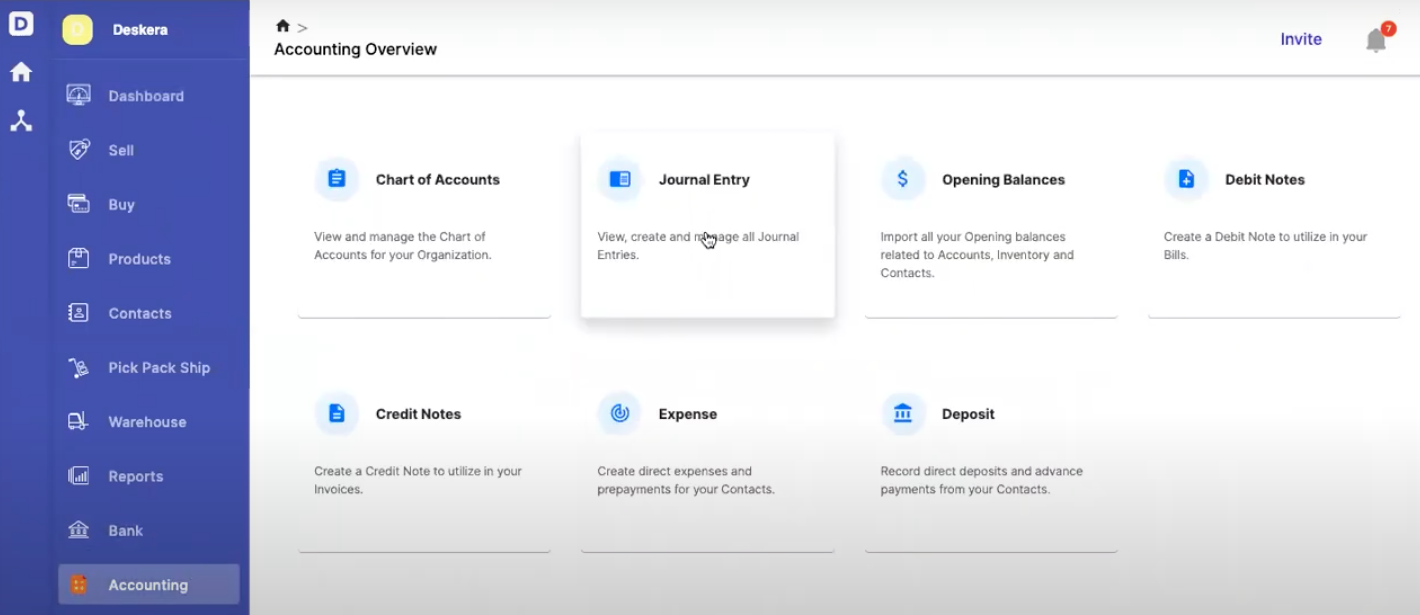
Here, you’ll be able to view, create, and manage all your journal entries. The main attributes displayed for every entry here are the journal entry number, the journal entry date, the journal entry type, and the related document number .

To view the details of each journal entry, you can press on the expand all records button. As you can see, the account name, debit amount, credit amount, and description will all appear .
2. Next, to manually create a journal entry, press on the create button on the top right . You’ll notice two journal entry options: normal or fund transfer. Each option depends on the type of entry you’re making.

3. Click JE - Normal . This will take you to the general journal page. The top half of the page contains the auto numbering format, currency, and journal date . There’s also an option that allows you to include the entry on the tax report . Then there’s the bottom half , where you can add the account, description, type, and amount .

4. Fill in all of these boxes with the appropriate information and press Save . Ta-da, you’ve created a journal entry!

What if you accidentally enter the wrong amounts? The software will notice and won’t save the journal entry . That’s what the “unbalanced account” on the bottom right of the page serves for. The exact off-balance amount will show.
Automate Journal Entry Creation Using Accounting Software
Businesses have moved on from the age of pen and paper for a reason. Using accounting software like Deskera will help you automate the entire journal entry creation process.
When your business creates an invoice , the corresponding journal entry is added automatically by the system in the respective ledger for Accounts Receivable, Sales, Sales Tax, etc...
Similarly, when a payment is processed, the bank and the accounts receivable are adjusted automatically by the accounting software.
Deskera , allows you to integrate your bank directly and track any expenses automatically. When you make an expense, the journal entry is automatically created, and it is mapped to the correct ledger account.
You can also create custom invoices using the provided templates, and send reminders to make sure you don’t miss out on any invoice payments .
To top it off, creating financial reports with Deskera is as easy as 1-2-3.
Still not sure? Well, luckily Deskera offers a completely free trial. You can sign up here and try out all 3 Deskera platforms - Books, Sales (CRM), & People (HRIS).
Key Takeaways
Hope our guide to journal entries was helpful!
For a quick recap let’s go through the main points we’ve covered:
- Journal entries record the financial transactions of a business . They’re the first step in the accounting cycle.
- Each transaction in a journal entry affects two accounts . One of them is debited, the other one credited. Simply put, debit is money flowing into a company, whereas credit is money flowing out.
- Never forget: debits and credit should always be equal in the end.
- To write a journal entry you need to figure out which accounts are affected, which items decrease or increase, and then translate the changes into debit and credit.
- A complete journal entry is made of 6 elements : a reference number, date, account section, debits, credits, and a journal explanation.
- You can record these journal entries into either a General Journal or a Special Journal .
- There are three main types of journal entries: compound, adjusting, and reversing .
- Use accounting software like Deskera to automate the process of creating journal entries, and save a ton of time!
Related Articles
Guide to Understanding Accounts Receivable Days (A/R Days)
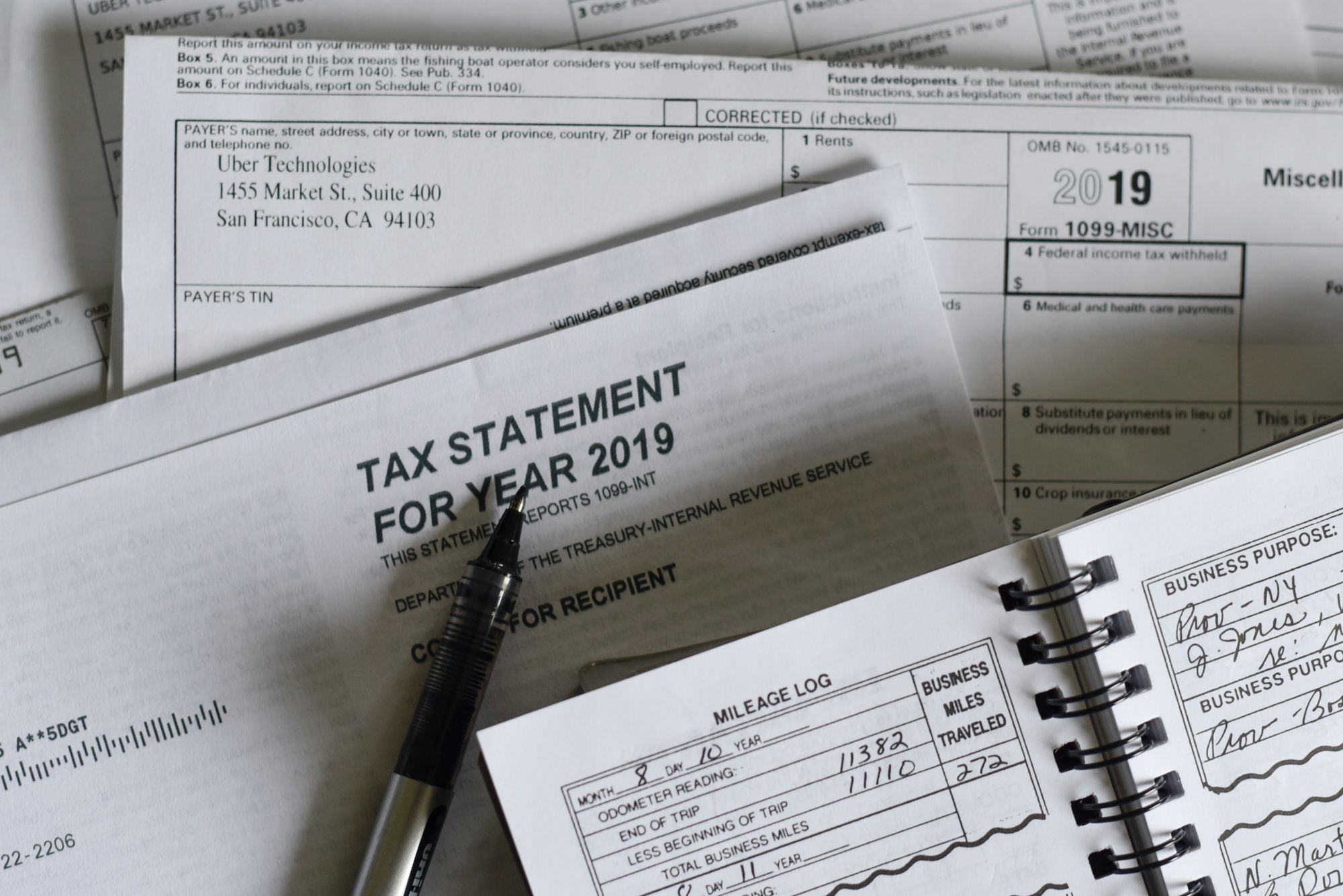

Everything You Need to Know About Professional Tax in Andhra Pradesh

Andhra Pradesh forms XXVI Letter of Appointment
Hey! Try Deskera Now!
Everything to Run Your Business
Get Accounting, CRM & Payroll in one integrated package with Deskera All-in-One .
- PRO Courses Guides New Tech Help Pro Expert Videos About wikiHow Pro Upgrade Sign In
- EDIT Edit this Article
- EXPLORE Tech Help Pro About Us Random Article Quizzes Request a New Article Community Dashboard This Or That Game Popular Categories Arts and Entertainment Artwork Books Movies Computers and Electronics Computers Phone Skills Technology Hacks Health Men's Health Mental Health Women's Health Relationships Dating Love Relationship Issues Hobbies and Crafts Crafts Drawing Games Education & Communication Communication Skills Personal Development Studying Personal Care and Style Fashion Hair Care Personal Hygiene Youth Personal Care School Stuff Dating All Categories Arts and Entertainment Finance and Business Home and Garden Relationship Quizzes Cars & Other Vehicles Food and Entertaining Personal Care and Style Sports and Fitness Computers and Electronics Health Pets and Animals Travel Education & Communication Hobbies and Crafts Philosophy and Religion Work World Family Life Holidays and Traditions Relationships Youth
- Browse Articles
- Learn Something New
- Quizzes Hot
- This Or That Game New
- Train Your Brain
- Explore More
- Support wikiHow
- About wikiHow
- Log in / Sign up
- Education and Communications
- Journal Writing
How to Start a Journal
Last Updated: March 21, 2024 Fact Checked
This article was co-authored by Nicolette Tura, MA . Nicolette Tura is an Empowerment Expert based in the San Francisco Bay Area. She holds a decade of experience creating change in various non-profits then went on to operate her own wellness business for 10 years. Most recently, she worked as a Therapy Associate to a chiropractic neurologist for 15 months working hands-on with patients, helping them heal from neurological disorders like concussions, long covid, migraines, and more. Nicolette guides groups and individuals on transformative meditation journeys and game-changing mindset management workshops and retreats on empowering everyone to keep expanding beyond past conditioning and self-limiting beliefs. Nicolette is a 500-hour Registered Yoga Teacher with a Psychology & Mindfulness Major, a NASM certified Corrective Exercise Specialist, and an expert in psychophysiology with experience in nervous system regulation and breath work. She holds a BA in Sociology from the University of California, Berkeley, and a Master’s degree is Sociology from San Jose State University This article has been fact-checked, ensuring the accuracy of any cited facts and confirming the authority of its sources. This article has been viewed 496,546 times.
In order to start a journal, you'll need a notebook, a writing tool, and a commitment to yourself. The first move is to write your first entry. Then, you can think about keeping up a regular journal! Use the journal as a way to explore your innermost thoughts and feelings – the things that you cannot tell anyone else.
Journal Entry Template

Preparing a Journal

- Choose between a lined or an unlined notebook. A lined notebook can be better for writing, while an unlined notebook might facilitate art and drawing. Think about how you prefer to set down your ideas, and choose a notebook that inspires you to fill it.
- If you plan to carry your notebook with you (in your purse, pack, or pocket,) make sure to use a notebook that is small enough to conveniently pack around.

- Consider numbering the pages. You can do this all at once, or you can gradually number the pages as you fill them. This can be a great way to keep track of what you write.

- Consider using a system that you can access with a password through a cloud or over the Internet. This way, you can open and edit your journal from any computer or device! Try WordPress , or even using your email client.
- For all the benefits of digital journal-keeping, you may miss the charm of a physical journal. Try it out, if you're curious. Consider keeping some notes in a physical notebook, and others in a drive on your computer.
Starting to Journal

- Write about what happened today. Include where you went, what you did, and who you spoke to.
- Write about what you felt today. Pour your joys, your frustrations, and your goals into the journal. Use the act of writing as a way to explore your feelings. Consider keeping a dream journal.
- Keep a learning log. Write about what you learned today. Use the journal as a way to explore and connect your thoughts. [2] X Research source
- Turn your experiences into art. Use the journal to write stories or poetry, to make sketches, and to plan out projects. Feel free to mix this in with your other entries.

- Imagine that you are talking to someone. Whether you are talking to a close friend or pouring your thoughts into a journal: you are putting them out into the world, and thus making them real. It can be hard to really get a grasp on what you're thinking until you make your thoughts real.
- If the timer goes off and you haven't finished journaling, then feel free to keep going. The point of the timer is not to limit you, but rather to spur you.
- This can be a great way to fit your journaling practice into the busy flow of everyday life. If you have trouble finding the time to write in your journal, then you may need to schedule it in. [7] X Research source
Keeping a Journal

- Carrying the journal around has the added bonus of keeping your words private. If you always keep your journal close, then it's less likely to fall into the wrong hands.

- Behind the books on your bookshelf.
- Under your mattress or pillow
- In the drawer of your bedside table
- Behind a picture frame
- If you do want to label it "My Journal" or "Private!" be sure to hide it well.

- Try scheduling journal time into your day-to-day flow. Some people journal before bed, or immediately after they wake. Some people journal during their daily commute or during their lunch hour. Find a time that works for you.

Community Q&A
Reader Videos
Share a quick video tip and help bring articles to life with your friendly advice. Your insights could make a real difference and help millions of people!
- Consider naming your journal. It might help you get into the writing mood if you feel that you are telling your story to someone. Instead of "Dear Diary," you could try something like "Dear Amanda," "Dear Julio," "Dear Puppy," etc. Thanks Helpful 19 Not Helpful 2
- Add personal information on the first page in case something happens to you and people need to know who to contact. This is also useful if you ever lose your journal. Don't add information that you aren't comfortable revealing, though. Thanks Helpful 16 Not Helpful 2

- Make sure to keep your journal safe if you don't want anyone to read it! Hide it where no one will find it: family, friends, acquaintances, or enemies. Thanks Helpful 87 Not Helpful 3
You Might Also Like

- ↑ https://www.theguardian.com/lifeandstyle/2014/mar/22/how-to-start-journal-writing-drawing
- ↑ https://www.niu.edu/citl/resources/guides/instructional-guide/reflective-journals-and-learning-logs.shtml
- ↑ http://psychcentral.com/lib/the-health-benefits-of-journaling/
- ↑ https://www.urmc.rochester.edu/encyclopedia/content.aspx?ContentID=4552&ContentTypeID=1
- ↑ Nicolette Tura, MA. Empowerment Expert. Expert Interview. 23 January 2020.
- ↑ http://www.artofmanliness.com/2009/06/07/30-days-to-a-better-man-day-8-start-a-journal/
About This Article

To start a journal, first find an empty notebook to write in. You can decorate the notebook with stickers, drawings, magazine clippings, or anything else you want to use to personalize it. Then, open to the first page and start the first entry by writing today’s date at the top. Journal about what happened to you today, how you’ve been feeling, what your goals are, what you dreamed about last night, or anything else that’s on your mind. Journaling can be a helpful way to reflect on your feelings, keep track of important information, or organize your goals and accomplishments. Try to set aside 10-15 minutes per day to write in your journal. Whenever you start a new entry, open to a new page and write the day’s date at the top. Remember to keep your journal somewhere safe if you don’t want other people to read it, like a drawer in your room or underneath your pillow. To learn how to pick a journal that’s right for you, keep reading! Did this summary help you? Yes No
- Send fan mail to authors
Reader Success Stories
Nov 21, 2023
Did this article help you?
Danielle Kassing
Jun 14, 2018
Amilia James
Jun 1, 2018
Kathleen Nelson
Aug 12, 2017
Abigail Johnson
Sep 27, 2017

Featured Articles

Trending Articles

Watch Articles

- Terms of Use
- Privacy Policy
- Do Not Sell or Share My Info
- Not Selling Info
wikiHow Tech Help Pro:
Develop the tech skills you need for work and life
What is a Journal Entry? How to Capture Your Life and Memories
How to use a journal entry to capture and preserve your thoughts, feelings, and experiences at a particular moment in your life..
February 15, 2023
Home » Day One Blog » What is a Journal Entry? How to Capture Your Life and Memories
When it comes to keeping a personal journal, journal entries are like the building block of your self-expression and self-discovery. Each journal entry adds to the foundation of your story, painting a picture of your experiences, thoughts, and emotions. As you continue to journal, the entries accumulate, forming a rich tapestry of your life that provides insights into your growth and personal journey. Whether you’re exploring your feelings, recording important events, or simply reflecting on your day, journal entries are the key to unlocking the power of personal journaling.
In this post, we’ll take a closer look at the definition of what is a journal entry. We’ll also cover how journal entries can be used to capture the essence of life, from your memories to your thoughts and reflections. From the elements of a personal journal entry to examples of journal entries, we’ll explore all you need to know about how to use a journal entry as a tool for self-expression and reflection. Whether you’re a seasoned journaler or just starting out, we hope this post will give you the information and inspiration you need to start capturing your life and memories in a meaningful and authentic way through your journal entries.
What is a Journal Entry?
A journal entry is a record of personal thoughts, feelings, and experiences kept in a personal journal or diary. A journal entry is a single entry within a larger collection of entries, which is known as a personal journal . A personal journal is essentially a collection of journal entries, usually organized chronologically, that document your thoughts, feelings, experiences, and personal growth over time.
The length of a personal journal entry can vary greatly, depending on your writing style and the purpose of your journal. Some people prefer to write just a few sentences or bullet points, while others may write several pages. There is no set rule for how long a journal entry should be.
A journal entry is a record of personal thoughts, feelings, and experiences kept in a personal journal or diary. A journal entry is a single entry within a larger collection of entries, which is known as a personal journal.
What’s important is that you feel comfortable enough to express yourself in a way that feels meaningful to you. Some people may find it helpful to set aside a specific amount of time each day or week for writing new journal entries, while others may choose to write a new entry whenever the mood strikes.
In general, the goal of a journal entry is to provide a safe and private space for self-expression and reflection. Depending on what works best for you, a journal entry’s length and format can vary widely. Whether it’s just a few sentences or several hundred words, the most important thing is that a journal entry is an honest and authentic reflection of your thoughts and experience.

Telling Your Story One Entry at a Time: How Journal Entries Build Your Journal
Think of a journal entry as a snapshot. Just as a snapshot captures a moment in time and freezes it for later recollection, a journal entry captures and preserves your thoughts, feelings, and experiences at a particular moment in your life.
Your journal serves as a collection of these snapshots, offering a glimpse into your personal history and the evolution of your thoughts and emotions over time. Each entry provides a window into your soul and a record of the journey of your life as you tell your story one journal entry at a time.
As a result, journaling can help you reflect on your past experiences and understand your current emotions, thoughts, and experiences in a new way. The journal serves as a record of this process of self-reflection and growth.
“A good journal entry—like a good song, or sketch, or photograph—ought to break up the habitual and lift away the film that forms over the eye, the finger, the tongue, the heart. A good journal entry ought to be a love letter to the world.” — Anthony Doerr
Personal Journal Entry vs Journal Entry in Accounting
It’s also worth noting that there are two types of journal entries:
- A personal journal entry
- A journal entry in accounting
In accounting, a journal entry is a record of a financial transaction in a company’s books of accounts. These types of journal entries are used to track the movement of money in and out of a business, as well as to document changes in the value of assets and liabilities. Journal entries typically include the date of the transaction, a description of the transaction, the amounts involved in the transaction, and the account or accounts affected by
Unlike a financial journal entry, which focuses on monetary transactions, a personal journal entry is a form of self-expression and reflection. Personal journaling can serve as a therapeutic tool to process emotions and experiences, track personal growth, and reflect on life experiences. Personal journaling can also be used as a creative outlet to express thoughts and ideas in a private and safe space. The frequency and format of personal journaling is completely up to the individual, as some people choose to write in their journals daily, while others write less frequently.
How Journal Entries Help Capture Your Life and Memories
Capturing life and memories is an important aspect of journaling. A journal can serve as a time capsule of your experiences and memories, providing a record of your life that you can look back on in the future.
Writing down your experiences and memories in a journal can help you reflect on your life and cherish the moments that have shaped you. A journal entry provides a way to preserve memories and moments that may otherwise be forgotten, especially as memories start to fade.
Keeping a journal can help you preserve your life story and the memories that make up your personal history. If you choose to share your journals some day, family members and future generations can read about your life and gain insights into your personality, values, and experiences, providing a unique and personal connection to the past. In this way, capturing life and memories is not just an important aspect of journaling, but it’s also a gift to future generations.
20 Common Elements of a Journal Entry
The elements of a personal journal entry should reflect your preferences, writing style, and what you hope to gain from the journaling experience. Here are a few common elements of a journal entry:
1. Today’s Date
Recording the date of each journal entry can help you track you progress and reflect on your growth over time.
2. Thoughts
The core of a journal entry are your thoughts at any given moment or on any given topic. Thoughts can take many forms, including ideas, opinions, beliefs, images, feelings, and memories.
3. Reflections
Reflections refer to the act of considering or contemplating your thoughts, feelings, and experiences. Reflection can take many forms, including introspection, self-analysis, and self-assessment. Reflections are often a central component of journal entries, as they allow you to process and make sense of their experiences
4. Gratitude
Many people choose to focus on gratitude in their journal entries, as a way to cultivate a positive outlook and focus on the good things in their lives.
5. Mood or Emotion
The writer may choose to document their emotional state at the time of writing, which can help them reflect on the connection between their emotions and experiences.
6. Positive experiences
Many people use journal entries as a place to document positive experiences, rather than dwelling on negative experiences or stressors. Regularly focusing on positive experiences can cultivate a more positive mindset and increase overall well-being.
Personal journaling can also be a space for setting and reflecting on personal goals, as well as documenting progress or setbacks as you work toward a goal. Here’s a bit more on journaling goals .
A journal entry can be used as a space for making plans for self-improvement.
9. Creative Writing
Some people use their personal journal as a space for creative writing, such as writing poetry, fiction, or personal essays.
10. Drawings or sketches
Some people incorporate drawings or sketches into their journal entries as a way to visually represent their thoughts and feelings.
Including photos in a personal journal can add a visual component to the written words, helping your remember and reflect on specific moments and experiences.
Videos can be a powerful tool for personal journaling, allowing the writer to capture the sights and sounds of their experiences, as well as their thoughts and feelings in the moment.
13. Audio recordings
Audio recordings can also be included in personal journal entries, providing a new way to capture thoughts and emotions. This format can be especially useful for individuals who struggle with written expression, or for those who prefer to express themselves verbally.
14. Weather info
Some people may choose to include information about the weather on the day of the journal entry, which can provide context and serve as a reminder of the conditions on that day.
15. Location info
The location info of a journal entry can be helpful for documenting your travels and your location as you write a new journal entry, reminding you of your environment or surroundings.
16. To-do List
While some people like to keep their to-do lists out of their journal, others embrace their journal as a place to keep track of their daily or weekly tasks.
Including quotes or lyrics that resonate with you can add depth and meaning to your journal entries, and serve as a source of inspiration or motivation. (Just check out these 101 quotes about journaling if you need inspiration.)
If you enjoy keeping track of your dreams, you may choose to include dream journaling as a component of your personal journal. Recording and reflecting on your dreams can provide insight into your unconscious mind and serve as a tool for self-discovery.
19. Mindfulness and meditation
If you practice mindfulness or meditation, you may choose to include reflections on your practice in your journal entries, documenting any insights or breakthroughs as you progress in your journey.
20. Physical sensations
Some people choose to include notes about physical sensations, such as hunger, fatigue, or pain, in their journal entries. This can provide a more holistic picture of their well-being, and help them identify patterns or connections between physical sensations and other aspects of their lives.
Journal Entry Examples
Having a few journal entry examples on hand can be a helpful resource if you’re needing more guidance on how to write a journal entry of your own. Perhaps these example journal entries can provide inspiration and guidance on what to include in your own entries, as well as how to structure and format your writing as you explore more journaling ideas .
Here are a few journal entry examples:
Traditional Journal Entry Example
This example journal entry shows a more traditional approach to journaling, recapping the day, how the writer felt, things they enjoyed, and other details from their day.
Today was a pretty good day. I woke up feeling well-rested and energized, which was a nice change from the past few days. I started the day with a cup of coffee and some time for reflection and meditation, which helped set the tone for a productive day.
At work, I had a meeting with my team to discuss our new project and things are really starting to come together. I feel confident in our abilities to succeed and make a difference with this project.
After work, I met up with some friends for dinner and we had a great time catching up and laughing. It was a much-needed break from the daily grind and it felt good to connect with them.
Before bed, I took some time to reflect on the day and write down my thoughts and feelings. Overall, I feel grateful for the opportunities I have and the people in my life. I am looking forward to tomorrow and all that it brings.
Templated Journal Entry Example
Using the common elements of a journey entry from above, here’s a more templated approach to a journal entry:
Date: May 5, 2022
Mood: Inspired
Today was a beautiful day, the sun was shining, and there was a light breeze. I went for a walk in the park and felt so grateful for the warm weather and all the beautiful sights and sounds around me.
Thoughts: I’ve been feeling really inspired lately, and I’ve been thinking a lot about my future and what I want to achieve. I’ve been feeling restless and like I want to make a change, but I’m not sure exactly what that change should be.
Reflections: Lately, I’ve been reflecting on my values, my passions, and what brings me happiness. I’ve been considering different career paths, and what kind of work would align with my values and give me a sense of purpose.
Gratitude: Today, I’m grateful for the beautiful weather, for my health, and for my family and friends. I’m also grateful for the opportunities that are available to me and the support I receive from those around me.
Positive experiences : Today was a great day. I got to spend some time outside, and I had a wonderful conversation with my friend over lunch. We talked about our dreams and aspirations, and it was so inspiring.
Goals: My goal for the next few weeks is to continue exploring different career paths and learning more about the opportunities available to me. I also want to focus on cultivating gratitude and finding joy in the little things in life.
Plans: My plan for the rest of the day is to read a book, do some yoga, and meditate. I also want to spend some time brainstorming and writing down my thoughts and ideas about my future.
Weather info: Today was a beautiful day, sunny and warm with a light breeze. I only saw a few clouds in the sky.
Location info: Today I went for a walk in the park near my home.
Today’s To-do list:
- Call Grandpa
- Fold the laundry
- Mail Chrissy’s Thank You note
- Work on essay for writing class
- Finish meal plan for the week
Gratitude Journal Entry Example
A gratitude journal is a type of journal that focuses on the practice of gratitude. Gratitude journaling simply involves regularly writing down the things you are thankful for, expressing appreciation for the good things in your life, and reflecting on how they contribute to your overall well-being. Here’s a simple example of a gratitude journal entry:
June 14, 2022
Five things I am grateful for today:
- The warm sun on my face as I walked to work this morning.
- The delicious breakfast I had with my family.
- The kindness of a stranger who complimented my new shoes.
- The laughter I shared with my coworkers during our break.
- The fact that I have a roof over my head and a bed to sleep in tonight.
It’s always easy to focus on what’s not going well. But taking time each day to reflect on the things I am grateful for helps me keep things in perspective. It reminds me that even on a difficult day, there are still many things to be thankful for.
Photo Journal Entry Example
Photo journaling is a journaling technique that utilizes photos as a way of documenting experiences. Many photo journals also include descriptions or captions of the photos, like in this example:
April 9, 2019
Today was a beautiful day and I wanted to capture some of my memories from it. I started the day by taking a walk in the park and it was so peaceful. The sun was shining and there were so many flowers in bloom. I took a few photos of the flowers and of the lake. The water was so still and it was the perfect place to sit and reflect.

After my walk, I went to have lunch with a friend. We had a great time catching up and I took a few photos of our food. We both love sushi, so we ordered a variety of rolls and they all looked so delicious.

In the afternoon, I went to a museum and it was so interesting. I took a few photos of some of my favorite exhibits, including one of the newer installations of digital artwork.

Before heading home, I took a walk through the city and I took a few more photos of some of the buildings and the people. It was such a busy and vibrant place, and I felt so lucky to be a part of it.

I’m so grateful for all of the experiences I had today, and I’m happy that I was able to capture some of them in photos. I can’t wait to see what tomorrow will bring.
Travel Journal Entry Example
A travel journal is a type of journal that documents your travels, experiences, and observations as you explore new places. Here’s an example travel journal entry:
Date: August 10, 2022 Location: Paris, France Weather: Sunny and warm, with a high of 25°C
Today was my first full day in Paris and it was truly magical. I started the day with croissants and coffee at a quaint café near my hotel. The flaky, buttery pastries were unlike anything I’ve ever had before. As I sipped my coffee, I took in the bustling city and people-watched for a while.
Next, I headed to the Eiffel Tower. The iconic landmark was even more beautiful in person. I took the stairs to the top and was rewarded with breathtaking views of the city. I felt so small and humbled by the sheer size of the tower and all of Paris spread out below me.
After some more exploring, I stopped for lunch at a small bistro recommended by my hotel concierge. I enjoyed a delicious meal of steak frites and a glass of red wine. It was the perfect way to fuel up for the rest of my adventures in Paris.
Later in the afternoon, I visited the Louvre Museum. I was completely in awe of the masterpieces housed within its walls. From the Winged Victory of Samothrace to the Mona Lisa, I was constantly amazed by the talent and creativity on display.
As the day came to a close, I headed back to my hotel, exhausted but also exhilarated by all that I had seen and experienced. I can’t wait to see what tomorrow brings in this beautiful city.
Example Journal Entry: Using a Journal Prompt
Many people utilize journal prompts as a way to write in their journal. Here’s an example of a journal entry that uses an example journal prompt.
What is a memorable moment from my childhood?
As I sit here with my journal, I can’t help but think back to a memorable moment from my childhood. I remember it was a sunny summer day and my family was on vacation at the beach. We were playing in the water, building sandcastles, and having a great time. Suddenly, a big wave came and knocked me over. I was scared and started to cry, but my older brother was there to pick me up and carry me back to the shore. He hugged me and told me everything was going to be okay.
This moment has stayed with me for all these years because it was a defining moment in my relationship with my brother. He showed me that he cared for me and would always be there for me, even when I was scared. As I think back on this moment now, I am filled with gratitude for having such a supportive and loving family. I am also grateful for the memories that I have from this day, which I will treasure forever.
Example Freewriting Journal Entry
Many people find that freewriting in their journal is the easiest way to complete a new journal entry. Freewriting is simply the a writing technique in which you write continuously without stopping, without concern for grammar, spelling or punctuation.
October 17, 2018 – Wednesday
Today I woke up feeling refreshed after a long night’s sleep. I made myself a cup of coffee and sat down on the couch, ready to start my day. As I took my first sip, I couldn’t help but think about all of the things I wanted to accomplish today. I have a meeting with my boss, a doctor’s appointment, and I want to get some work done on a project I’ve been putting off. But before I dive into all of that, I just want to take a moment to write and let my thoughts flow.
I’ve been feeling a bit overwhelmed lately with all of the responsibilities I have on my plate. It seems like there’s always something that needs my attention and I find myself constantly rushing from one thing to the next. But in the moments when I slow down and take a deep breath, I feel like I can handle it all. I just need to remember to make time for myself and focus on what’s important.
I’ve been thinking a lot lately about what success really means to me. I used to think it was all about money and status, but now I’m not so sure. I think success is more about finding happiness and fulfillment in what you do, and making a positive impact on the world. That’s what I want for myself, and that’s what I want to focus on moving forward.
Well, time to get going. I feel a little more focused and at peace now that I’ve taken the time to write in my journal.
Digital Journal Entry Example
Some people find that keeping a digital journal is easier than writing in a notebook. A digital journal has several advantages, such as the ability to add video, audio recordings, photos. Digital journals can also be searched more easily as many journal apps like Day One have search and sort functionality. Your journal can also be accessed on multiple devices, such as your desktop computer and your mobile phone.
Here’s an example of a digital journal entry made in the Day One journal app :

Journal Entry Prompts
For your next journal entry, here’s a list of some common journal prompts to jumpstart your journal writing on a daily basis:
- What’s on my mind today?
- How am I feeling today? What emotions can I identify?
- How is my body feeling today?
- What am I grateful for today, and why?
- What happened today?
- What made me happy today, and why?
- What made me feel proud today, and why?
- What did I learn today? How can I apply that knowledge to my life?
- What challenges did I face today?
- What is one way to make today better?
- Who has made my life better recently?
- What is a memorable event from my childhood?
- What are my hopes and goals for the future?
- What am I looking forward to in the near future?
- What is one way I’d like to grow or change?
- What is something I’m curious about, and how can I explore it further?
- What are some of my favorite quotes, and how do they inspire me?
- What is something that I’ve been putting off, and what steps can I take to get it done?
- What is something I can do to show kindness to someone else today?
- What are three things I can do to take care of myself today?
Wrapping Up: Journal Entries and the Essence of Life
Keeping a journal is a meaningful way to reflect on your thoughts, emotions, and experiences. Whether you prefer to write about your gratitude, your goals, your travels, or just your day-to-day life, journaling can help you process and make sense of your journey.
With its many elements, techniques, and forms, there is no one “right” way to journal. The key is to find what works for you and to make journaling a regular part of your life. So go ahead, start capturing your life and memories today in your next journal entry!
Start Your Journal Entry Today in the Day One Journal App
The Day One journaling app makes it easy to build and maintain a daily journaling habit. Daily journaling reminders , writing prompts , and journaling streaks are designed to help keep you motivated and consistently journaling.
About the Author
Kristen Wright is the author of three books on journaling. With a passion for writing and self-reflection, Kristen uses her experience with journaling to help others discover the benefits of documenting their thoughts, feelings, and experiences. In her role at Day One, she helps to promote the power of journaling so people from all walks of life can experience the transformative power of journaling.

Share this:
Journal from here, there, everywhere..
Download the Day One journal app for free on iPhone, Android, iPad, Mac, and Apple Watch.


How to Write a Journal Entry

Have you always wanted to express yourself but you just would not like to share it with somebody? Then writing journal entries can be of great of help to you especially if you want your thoughts materialized into words. Plus, you do not have to be worried about having another person knowing about it.
- 19+ Travel Journal Writing Examples
- 5 Reflective Writing Examples & Samples

Understanding Journal Entries
Journal entries are pieces of writing, which come individually, that will take and fill up a journal or even an ordinary notebook. It is in a journal entry where you will be able to express yourself, your personal growth, your interests, your opinions, and even the mundane things you have done and encountered in a day.
Journal entries usually come in between 500–1000 words. A journal entry may not be connected or related to a previous or the following entry unless stated. Journal entries are considered as something that is private since it is where you can be able to write with no holds barred.
When it comes to content, a journal can contain anything and everything. You can include a chronicle of what happened in your day, the summary of your deep thoughts, and you could even include your to-do tasks for the next day or tasks that you have already completed within the day.
When you would decide to write journal entries for the first time, you may want to consider starting with writing even the most ordinary events that happened in your day, the secrets you want to spill but could not spill to others, and even your most random train of thoughts.
You could also get assigned to write a journal entry for school, you may have to read the stated instructions properly as it could contain only the necessary items that you have to write for your journal entry assignment and that it could also save you some time from writing irrelevant content.
Starting a Journal
Before you would step into the world of journal writing, you just have to have the will to write in the first place. Without the will and the desire to write a journal entry, you will surely not reach even to the half of your journal. You might get discouraged at first especially if you are not confident with your writing, but do not worry because you do not have to be a renowned author to start a journal.
Keep in mind that when in writing a journal, you just have to be honest with yourself. Once you are assured that you really are willing to start writing a journal, here are the steps that can guide you:
1. Decide a comfortable space to write.
There are two spaces to consider when writing a journal. First, you have to consider where you are going to sit when writing a journal and the second is where you should be writing your journal entries.
For the first space, you have to decide on a place where you are at your most comfortable state that you would not be worrying that someone is standing behind you reading your journal entry. You would not want that, right? Additionally, you might want to remember some things that happened during your day and that you could not do so if there will be background noises and distractions as you write.
For the second space, you have to decide on a writing space where you would be writing your journal entry. Do not write anywhere and choose a kind of writing space, be it a notebook or a journal, where you will be able to write comfortably as well. You could also opt for a digital journal where you can easily add, edit, or delete some parts easily without having to deal with the mess; plus, you could easily add other elements, such as photos, that could make your journal entry more detailed.
2. Reflect on your day and ask yourself questions.
Once you have found a perfect place to write and a perfect writing space to write your journal entry on, you should now have to reflect on what happened during your day and what are the events that are journal-worthy for you. You do not have to write on this step.
If you are a newbie at journal writing, do not be too hard on yourself and just write what you can manage to write since your journal entry can just be about anything you want. If you want to write down the moments in your day that you want to have a keepsake out of, you can totally do it even by just closing your eyes and reflecting on what happened throughout your day, including what you may have felt about it.
If you find it hard to reflect, you can just start on basic questions that could help you generate content for your journal entry.
3. Start writing!
You already have what you need so that only means that the only thing left to do is the actual writing of your journal entry.
Again, if you are a beginner at writing journal entries, you can start with simple sentences that start with “I feel,” or “I think,” or “I wonder.” Also, do not be afraid to have a central topic for your journal entry and do not be afraid to exclude some parts of your day that you don’t feel recording, most especially if it is just too mundane and basic, such as taking a bath. Unless something remarkable happened during your bath, then you might find it important to write it down. Make sure that you make your journal a space where you can feel at your most comfortable state.
However, if you are to write a journal for an assignment in one of your classes, be sure that you will be able to follow the instructions given by your teacher or professor.
4. Re-read and add.
When you would get into writing your journal writing, there is a tendency that you might forget some things, this is why it is advised that you should go back and re-read your journal entry right after writing it. It is not really necessary for you to check whether grammar, especially the spelling and syntax, is done right and flawless, but if you see the need to edit it since it can affect the message you want to convey, then, by all means, do so.
However, if it is a journal assignment, make sure that you would also check up on your grammar and syntax since your journal will be graded by your teacher.
Additionally, add and enter any missing details on your journal entry once you notice it during your re-reading period. Write it down immediately for it may be difficult to try and remember about it the next time.
Tips for Writing Journal Entries
If you are just getting started to write your first batch of journal entries, it could get difficult for you at some point. However, once you would finally get the hang of it, your journal entries would just easily flow. Here are some tips you can make use of should you want to get better at this activity:
1. Be creative.
Journal entry writing has no limits. You do not have to stick to words and long paragraphs if that bores you. You can make use of any visual material, such as an artwork or a photograph that would make your journal writing even more memorable.
2. Write a dialogue and a memory
In your day, you might have gotten yourself into a conversation so striking you want to have a record of it and you can freely do so on your journal entry. If there was a significant moment that happened to you on that day, write it as a memory on your journal entry. When you find starting to write an entry journal difficult, you can always go these basic things to write and start from there.
3. Set a schedule.
As we mentioned earlier in the article, setting a schedule is a great first step. Decide how many times you want to write and set a schedule. Whether it be once a day, or once a week, decide on a time you want to write and don’t skip it.
4. Have fun.
Of all the things that have been written above, the only thing that you should always stick in your mind is to have fun while writing your first batch of journal entries. It is in having fun that you would just let go of anything that holds you back from writing what you want to write and just let your pen, your hand, and your thoughts do all the action.
Journal entry writing is not a chore or a requirement (unless it’s a given assignment) that you should feel so much pressure from. Free yourself from doubts and just write.
AI Generator
Text prompt
- Instructive
- Professional
10 Examples of Public speaking
20 Examples of Gas lighting
Please share :
Voted #1 Photo-journaling app ★★★★★

Item added to your cart
How to start a journal entry with easy steps.
Written by: Murad Huseynov
October 10, 2023
Time to read 9 min
Journaling is an incredibly rewarding practice that improves your wellbeing and provides many other benefits. So if you’re interested in learning how to start a journal entry with easy steps, keep reading.

Key Takeaways
- Journaling is a fantastic way to improve your life, but it requires consistency.
- Find the right environment to start writing, such as a cozy room at home or a coffeeshop.
- By dedicating a portion of your time to journal entries, you’ll enjoy a range of benefits.
- If you’re struggling, start off with small journal entries before expanding on your ideas.
Table of Contents
Murad Huseynov
Murad is the founder of Mosaic Journal, based in London, United Kingdom. He is an expert on photo gifting, photo printing and photo journaling.
How To Start A Journal Entry
Starting a journal is an admirable pursuit that can offer a multitude of benefits. Although it may feel like a chore at first, by committing to journaling you create a safe space for you to reflect, process your emotions and grow as a person. To help you along your path towards journaling, let’s go over how to start a journal entry by breaking it down into easy steps:
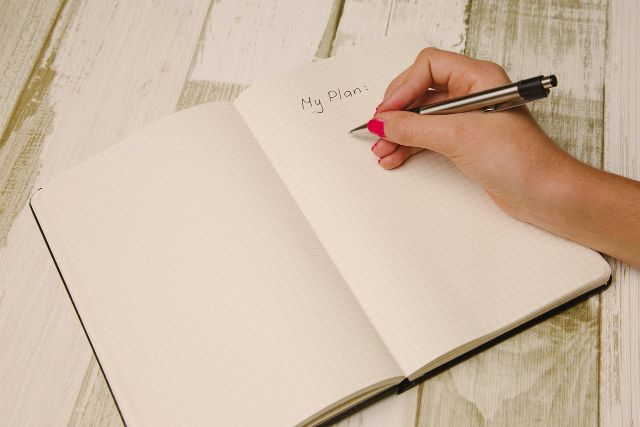
Preparing To Write: Setting The Stage
Writing in your journal can be encouraged by creating a space that allows the creative juices to flow. So find a quiet, comfortable location where you won’t be disturbed during your writing. This could be a cozy nook at home, a quiet part of a park or somewhere else that you find relaxing. By providing yourself with a dedicated writing space, you give yourself the best chance to write and reflect.
Another great way to lay the foundation for your journal writing is to establish a consistent schedule . By setting aside a specific time of day to write, such as first thing in the morning or just before bed, you solidify a routine. By sticking to this schedule, you’re much more likely to write consistently.
Finally, you’ll want to remember that the things you write in your journal are private . By ensuring that your work is private, you’ll feel much more comfortable about writing openly. So keep your journal safe and secure so that no one else can get to it.
Deciding What To Write About
A blank page in your journal can feel quite overwhelming, especially if you don’t know what to write about in the moment. So to help you decide on a topic, reflect on your day and think about the high’s, low’s and talking points of the day. You can also prompt yourself by asking questions like, ‘what made me happy or sad today?’. This should help guide your writing process.
If you’re really struggling to decide what to write about, then brainstorming is also a viable option. Think about things like your aspirations, a favorite book you’ve read recently or a social topic that’s been bothering you. You can even use external media like television shows or photographs to inspire your writing.
Framing Your Entry
Framing your entry can give you some clarity around how you’ll write in your journal. A good way to start this is by creating an opening sentence that conveys your current mood or thoughts. Other ways to begin your entry is by using a quote you like, asking a question or making an observation. Be sure to add other key details alongside your journal entry, like the date to provide a bit more context and structure around your writing. You might also want to give each entry a title to clearly denote what you’re writing about.
Diving Into The Writing Process
The writing process itself will vary from person-to-person and page-to-page. So try not to overthink what you’re writing and let your ideas spill out onto the page. To help with this, you can try to write quickly to capture the essence of your thoughts. You won’t be filtering what you write as much if you do so quickly, providing you with a more genuine reflection of your thoughts and ideas.
Another important aspect of the writing process is honesty. Don’t feel compelled to sugar coat how you feel or write in a way that you think other people will enjoy. Your journal is a personal thing, so don’t pander to others with your writing as it gets in the way of genuine content. Finally, if you feel overwhelmed by the process of writing, consider giving yourself a 5 or 10 minute timer to help with focus.
Enhancing Your Journaling Experience
If you really want to enhance your journaling experience, then consider adopting the following tips into your writing process:
- Write a list: A list can help clearly break down your ideas and declutter your thoughts. You can use the bullet points as starting off points before expanding them.
- Re-read entries: Once you’ve written a journal entry, re-visit it and try to find ways to embellish or build from what’s already there.
- Enjoy the process: Ultimately, the process of writing in your journal should be fun. So make sure you enjoy your time journaling by including sketches, doodles or other fun things.
- Finding a rhythm: Although keeping a consistent writing schedule is important, don’t be afraid to listen to your instincts. If you find yourself in a rhythm with your writing, keep going.
What Are The Benefits Of Journal Entry?
Writing in your journal is a cathartic process that encourages your own growth and development. Not only is it an inherently creative pursuit, but it offers a lot of benefits to your overall life. Let’s go over how this transformative process can benefit your life:

Processing Emotions
One of the biggest benefits of journaling is the ability to unpack and understand your emotions . The act of writing is a therapeutic process, allowing you to unload your emotions on the page. By doing this, you can process more complex emotions you feel, which in turn helps lower your stress and anxiety levels.
Knowing Yourself
Journaling allows you time to reflect on your thoughts and feelings about things. By doing this, you’ll glean a deeper understanding of who you are as a person. This enhanced self-awareness gives you the power to recognize patterns in your behavior, leading to personal growth and development alongside improved decision-making abilities.
Improved Memory
The process of writing things down can help improve your cognitive functions . You’ll be creating stronger memories of things by writing them out, which helps to solidify your short and long-term memory comprehension in the process.
Setting Goals
Journaling is a fantastic way to set goals in your life by clearly outlining them . As you progress towards your goal, you’ll have created a neat timelines of your progress. This not only makes it feel more tangible and realistic, but it encourages you to keep going. This additional motivation can make achieving the goals you set much easier.
Creativity Boosting
Journaling is a creative process in its own right, so working on this practice can help boost your creativity levels. Whether you’re jotting down your thoughts, scribbling a doodle or writing a story, the process stimulates the creative side of your brain. Even working on something random can help trigger more creativity to help you in other areas of your life.
Improved Communication
By journaling consistently, you’ll be improving your communication skills . The process of writing will enhance your ability to articulate thoughts and present your ideas more clearly. This extends beyond your written communication as it can help improve how you talk with others.
A History of You
Over time, your journal will serve as a document that outlines your personal history . From the wins to the losses of your life, your journal will contain pages that capture your day-to-day life. In the future, you’ll be able to revisit these pages and travel back through your own past. So your journal actually acts as a bit of an autobiography or memoir.
Tips To Make Journal Entry A Habit
Remaining consistent with your journaling can prove to be difficult. Life often gets in the way and staying motivated can become a challenge. However, if you really want to get the most out of your journaling journey, then it helps to make it a habit. So, to help you stick with your journaling, here are a few tips to make journal entry a habit:
- Start small: Try not to get overwhelmed by the process of journaling by keeping entries small. Even a few sentences can be enough to keep the habit going. Over time, you’ll feel more confident in your abilities and will likely write more.
- Set a schedule: One of the best ways to make a habit out of journaling is to stick to a set schedule. Whether you decide on writing first thing in the morning or last thing at night, find a time you can stick to.
- Find the right space: Make sure you have a suitable space to write your journal entries. It should be a quiet, relaxing space where you won’t be disturbed while writing.
- Use prompts: Prompts can be a useful tool if you’re really struggling to put words on the page. These prompts are available online and can help encourage you to write about different topics or themes.
- Make it personal: Your journal entries are going to be very personal, so make the rest of the journal unique to you. Include drawings, stickers and other decorations that you like. This should encourage you to interact with your journal more and write consistently. Set reminders: If you’re a forgetful type, then setting alarms and reminders can be a great way to stick to your journaling.
- Make it a challenge: Set yourself a challenge of writing an entry every day for 30 days. If you like the idea of a challenge, then framing your journaling as a contest of will can really help you stay motivated.
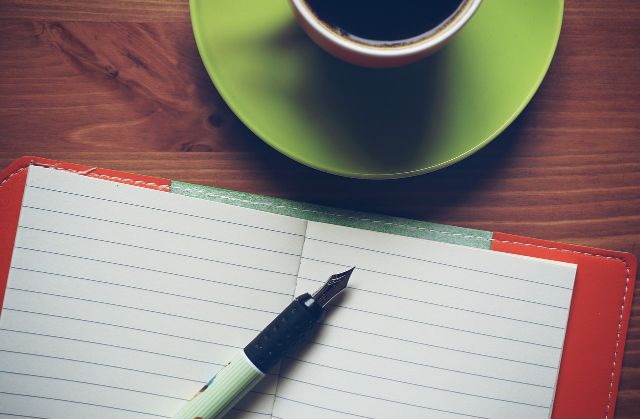
Frequently Asked Questions About How To Start A Journal Entry
If you want to start a journal entry but don’t know how, try not to overthink things too much. It should be a simple and fun experience that lets you express yourself freely. Try to follow these steps when writing a journal entry: • Find a quiet space to write, like a secluded room in your home or a cozy nook in a coffee shop. • Choose between a digital journal or a traditional, paper-based journal to write with. • Include some basic details like the date and a possible title for your entry. • When it comes to actually writing the entry, try to let the ideas flow freely. Don’t censor yourself and let things flow as naturally as possible.
Using a journal to create journal entries unlocks a lot of benefits that range from improved mood to stronger communication skills. A few key benefits associated with journaling include: • Emotional processing: Your journal is a safe space that lets you process emotions more readily. Improved self-awareness: You’ll understand more about yourself, your thoughts processes and your emotional patterns by journaling consistently. • Improved memory: When you write about things in your journal and reflect, your memory comprehension improves. • Creativity: You’ll become more creative by practicing free-flowing thoughts in your journal entries. • Recording your life: You’ll be creating an account of your life in your journal, which you can refer back to in the future.
If you want to make journaling a habit that you stick with, then consistency is key. Make a schedule for your writing and stick to it. Or, make a challenge out of it and try to write for 30 days without missing a day. There are other things you can do to make sure you write consistently in your journal, such as: • Finding the right space to write. • Using prompts to help with ideas. • Write for as long or little as you like. • Be kind to yourself and don’t judge your writing.
Our Most Recent Articles

Blog post title 1
Blog post title 2
Blog post title 3
- Choosing a selection results in a full page refresh.
- Opens in a new window.
How To Write A Journal Entry
Student level.
Downloads: 553
Video Length: 1:00
Updated on: 01/04/2021
Lesson Time: 1–2 hrs.

Unlocking this lesson costs 1 credit and will give you full access to the printable lesson plan, interactive lesson plan, and teacher's guide. Click here to get credits.
Lesson Description
Video description, lesson activities.
Lesson Topics
How-To, Health, Lifestyle
Lesson Preview
Similar lessons, ready to get this lesson plan.
You can get a lesson credit for $2.99 to download this lesson. We've also got other options for a better value.
Confirm Lesson Download
You can unlock the full lesson materials for How To Write A Journal Entry for 1 credit. Are you sure?

Your download is ready. You can open your lesson from your device or in your browser. Enjoy your lesson!

Journaling For Mental Health: How To Do It Effectively To Improve Mood And Well-Being
Here's what the science says.

“Journaling can be a powerful way to organize your thoughts, feelings, and ideas, leading to increased self-awareness, self-discovery, and growth,” says Jaci Witmer Lopez, PsyD, a licensed clinical psychologist based in New York City. “In my practice, I've seen firsthand how regular journaling can transform lives.”
Maybe you've kept a fitness journal in the past to help you stay on track toward your wellness goals, or you currently have a gratitude journal to stay grounded. There are travel journals to help you document your adventures, and if you’re less artistically inclined, there are even journaling apps to help you stay mindful on the go. Below, experts share the benefits of journaling for mental health, how to start one yourself, and specific writing prompts for inspiration.
Meet the experts: Jaci Witmer Lopez, PsyD , is a clinical psychologist based in New York City. Marc Campbell, LMHC , is a licensed therapist based in Orlando, Florida, and the author of I Love My Queer Kid .
Common Benefits Of Journaling
Apart from having a dedicated place for juicy diary entries, there are several general benefits of journaling. The practice has been shown to help people process stressful events, according to a study published in Annals of Behavioral Medicine . In another study about college students, researchers found that journaling may improve self-efficacy —in other words, it can help you believe in yourself. Writing has even been studied as a behavioral intervention for children—so if you have kiddos at home, encouraging them to write may not be such a bad idea.
Common benefits of journaling include:
- Finding inspiration
- Creative expression
- Tracking your goals
- Fun freewriting
- General reflection
- Brainstorming ideas
5 Mental Health Benefits Of Journaling
Apart from its general benefits, here's how journaling can impact your mental health, specifically, according to experts.
1. It can help you process (and learn from) your emotions.
“Remembering the events from your day—both the ups and the downs—can help your brain practice processing and regulating your emotions,” says Marc Campbell, LMHC, a licensed therapist based in Orlando, Florida. For instance, if you’re feeling rejected from a recent breakup or you're burned out at work, writing about how you feel and reading it back to yourself can help you process the difficult emotions. Journaling can also help you recognize certain patterns, practice more acceptance, and have more empathy for yourself, Campbell says.
2. It can help you heal from traumatic events.
Journaling can significantly impact your ability to process and heal from trauma, Lopez says. “ Research has shown that writing can reduce symptoms of depression, anxiety, and post-traumatic stress disorder (PTSD),” she says. “When you write things down as opposed to just thinking about them, you hold yourself accountable to reframing or changing your narrative.” Although the mental health effects of trauma won’t disappear by simply writing down how you feel, journaling can be a helpful practice in addition to seeking therapy and trauma treatment .
3. It may help you manage anxiety and depression.
Anxiety and depression are among the most commonly cited mental health struggles in America, per the American Psychological Association (APA). And although having a writing practice won't cure these conditions overnight, journaling may have the potential to decrease depression and anxiety and improve resilience over time, according to a recent study . Plus, if you’re struggling to find meaning in everyday life or you feel generally disengaged—both of which are common experiences when facing mental health challenges— some studies suggest that journaling may help.
4. It can help you track your therapy progress.
If you're seeing a therapist right now, journaling can help you check in with yourself daily or weekly about how it’s going—or even help you hold yourself accountable for certain behaviors you’d like to change, Campbell says. “Through the process of journaling, you can reflect on past entries and potentially learn about any patterns you have,” he says.
You can also use a journal to reflect on what, exactly you speak about during your therapy sessions and begin to process how you’re feeling about it, Lopez adds. An added benefit? One day, you can look back at your journal and celebrate how far you've come.
5. It can help you practice self-compassion.
Whether you're dealing with a specific mental health issue or you're simply feeling overwhelmed, negative self-talk, shame, and embarrassment are common. It can be difficult to be kind to yourself, however, practicing self-compassion can go a long way, experts say. A recent study in the American Journal of Speech-Language Pathology found that daily journaling as a mindfulness practice led to increased levels of self-compassion, and another study on registered nurses found that journaling can boost compassion and help manage burnout.
How To Start Journaling For Mental Health
If you aren't someone who spilled your heart out in a childhood diary, don't worry—journaling can be as simple as jotting things down on your phone, in a notebook, or responding to a specific prompt to get inspiration (more on that soon).
There’s no “right” or “wrong” way to journal, but it should be a personal process, Campbell says. “I recommend starting journaling in the way that feels most authentic to you. If you prefer pen and paper, start with that. If you prefer typing things out in your notes app, that works, too. If you aren’t sure, try both and more—a laptop or even typewriter if you’re feeling adventurous,” he says. Also, writing for mental health is personal, but you shouldn't feel pressured to document your whole life story all at once (unless you want to).
Whether you incorporate journaling into your morning routine or you attempt five minutes before bedtime to free-write, experts recommend starting slow. “If you're new to journaling, my advice is to start small and be patient with yourself. Set aside just a few minutes a day to begin with, and gradually increase the time as you build the habit. It’s important to find a method that you'll stick with consistently," Lopez says. Try to pace yourself and make the practice as manageable as possible so that it becomes a habit formed over time, she adds.
10 Journal Prompts For Mental Health
- What was the highlight of my day?
- What was a lot moment of my day?
- What's a challenge I'm facing right now?
- What people, places, or things am I grateful for and why?
- Who is someone that's inspired me lately and why?
- What are three things I'm proud of myself for, and why?
- What is a small act of kindness I can do for myself this week?
- What is one limiting belief I have about myself? (And is there a way I can begin to reframe it)?
- Describe something you are struggling with. Then, read it from the perspective of someone you care about. What would they have to say about it?
- If I could change an aspect of my mental health and well-being right now, what would it be and why?
When it comes to journaling for mental health, consistency is key. Whatever method, prompt, or format you choose, your mental health will thank you.
Best Journals For Mental Health
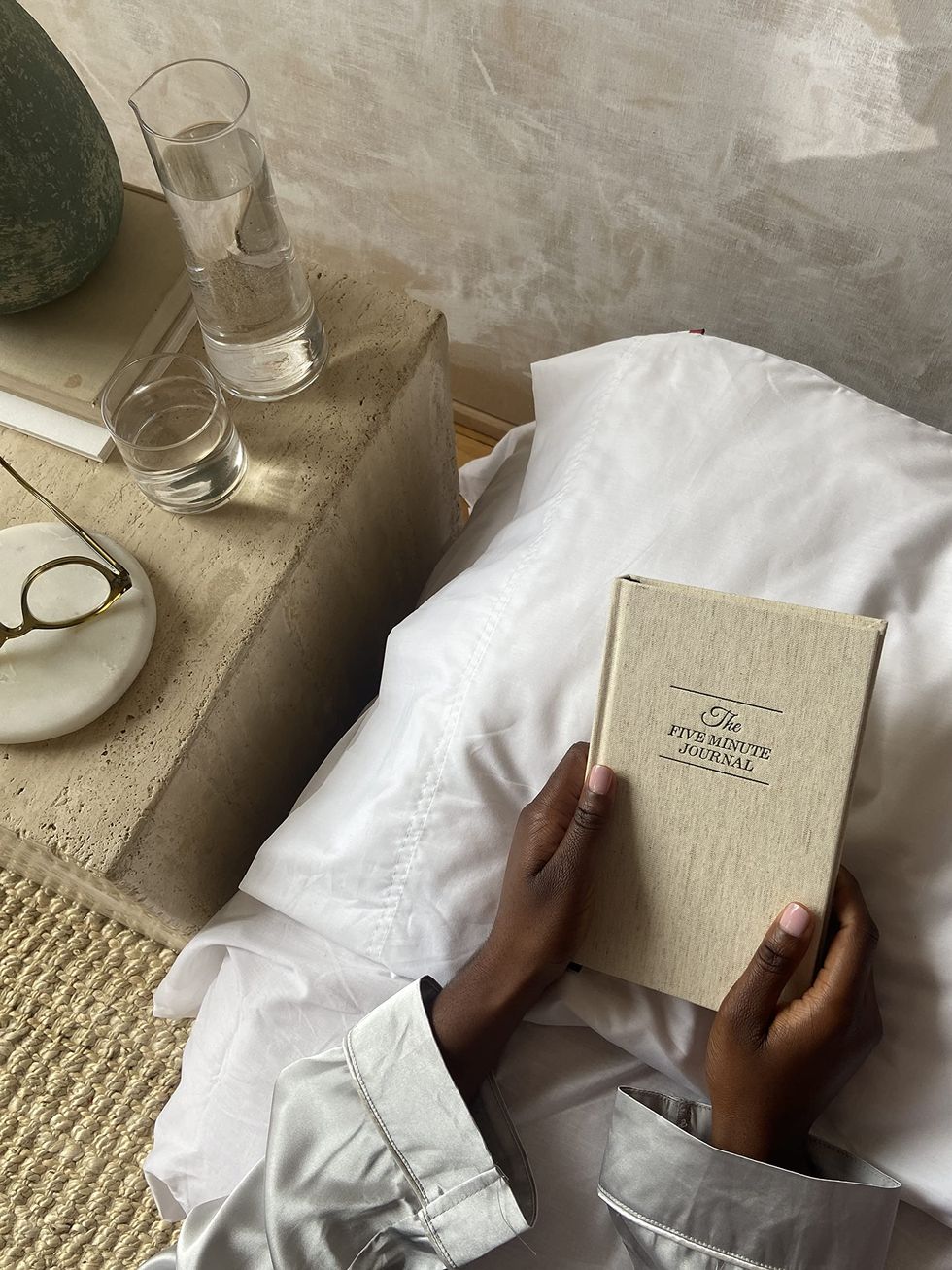
The Five Minute Journal
Looking for a simple, sleek journal that will help you practice more mindfulness and gratitude? This popular option might be a good fit for you. It encourages you to cultivate a sense of calm for just five minutes a day, but there are plenty of helpful tools packed into the journal itself—like prompts, daily highlights, weekly challenges, affirmations, and more. If you're brand new to journaling for mental health, this one provides clear cues and outlines to help you self-reflect and feel more confident. Plus, it's aesthetically pleasing. What could be better?
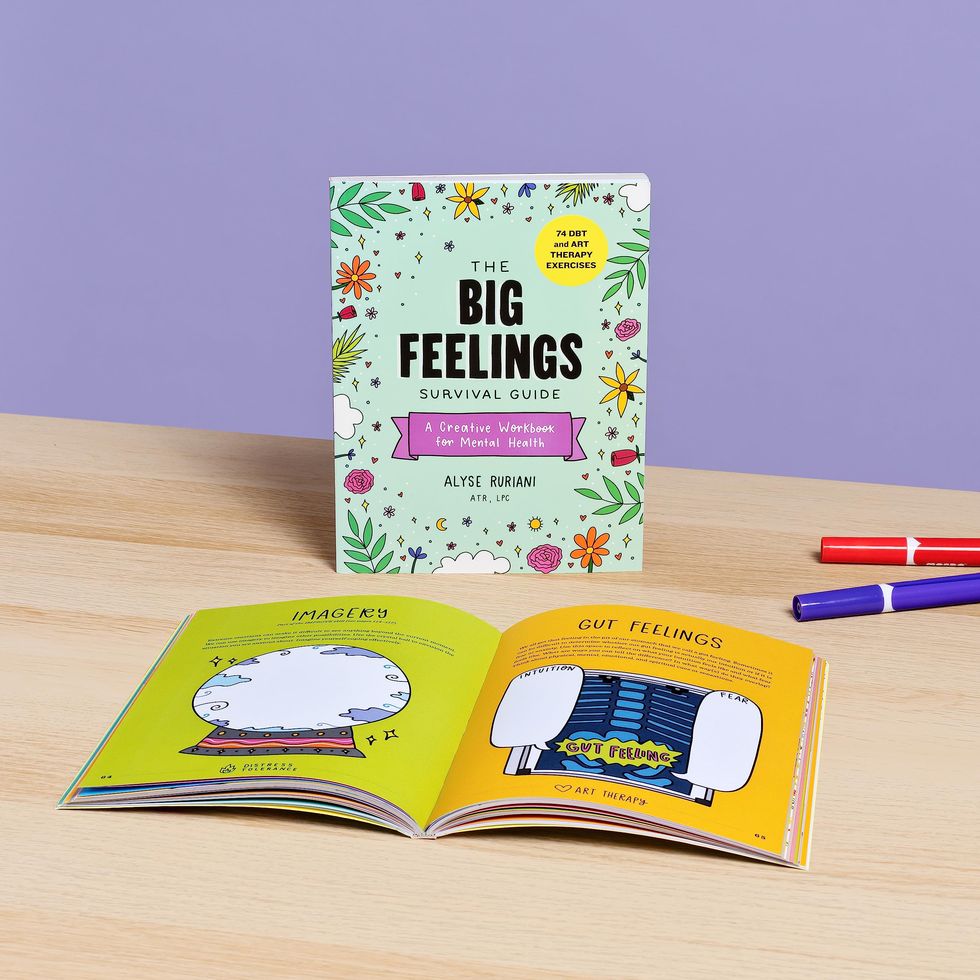
The Big Feelings Survival Guide
This colorful, activity-filled workbook by licensed art therapist Alyse Ruriani, LPC, is a great option if you're ready to dive into mental health in a fun, accessible, yet meaningful way. The workbook includes practical and creative activities that are all rooted in dialectical behavior therapy (DBT), which, ICYMI, is a revolutionary treatment that helps people move through emotions. Not only will you gain major insight about your mental health journey, but the workbook itself is super bright and engaging—the helpful illustrations and eye-opening exercises are sure to help you reflect and gain inspiration.

Self-Love Workbook for Women
This self-love workbook by therapist Megan Logan, LCSW, is uniquely designed to help you release self-doubt and have more self-compassion. The journal includes quizzes, writing prompts, and fun activities to help you cultivate more self-love, like writing a message to your younger self and making a "happy playlist." You'll also find empowering affirmations for those days when your mental health isn't so good—plus, the journal provides helpful resources for goal-tracking, identifying emotions, and embracing who you are.
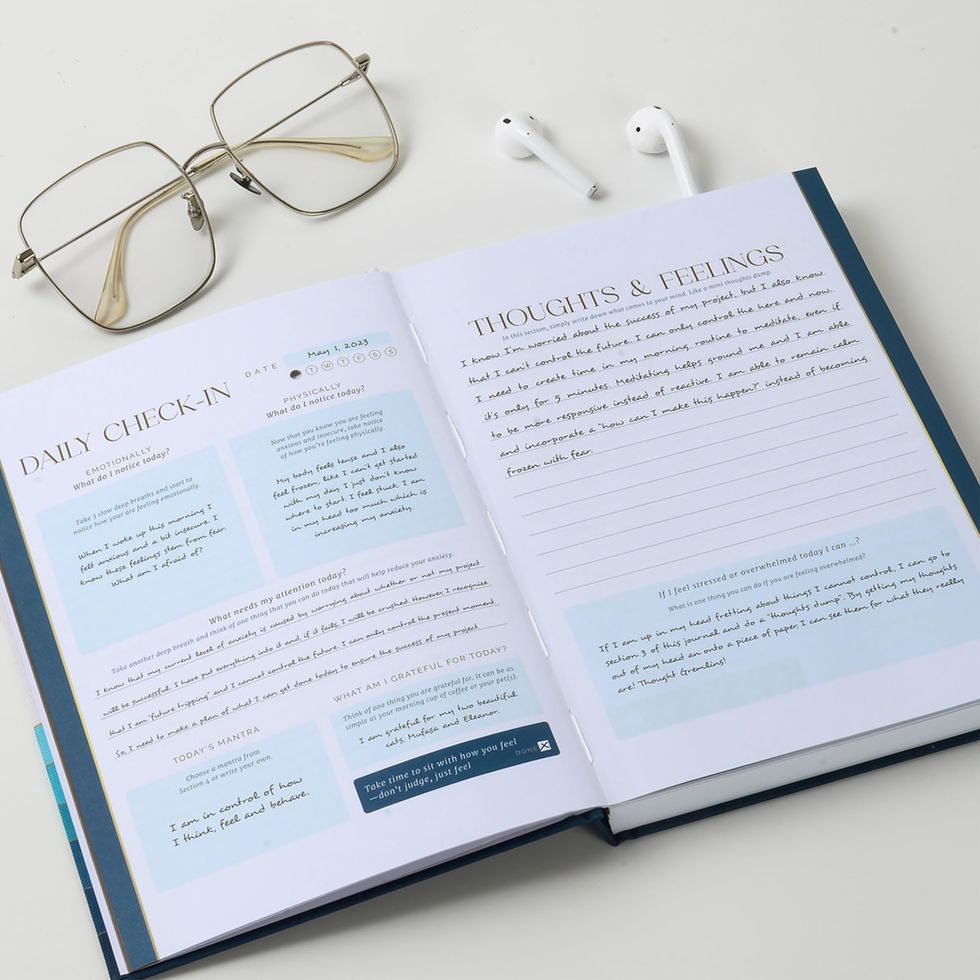
90-Day Mental Health Journal
This easy-to-follow journal encourages you to care for your mental health in a holistic way. If you're dealing with stress, anxiety, or uncertainty about the future, the journal claims to help you self-reflect and gain self-awareness while focusing on the power of the present moment. This journal is ideal for anyone who wants to breathe, reconnect with themselves, and cultivate more mindfulness. It comes with grounding activities and daily check-ins to help you keep track of your emotions—and understand their roots.
Lexi Inks (she/her) is a lifestyle journalist based in Jacksonville, Florida. She has reported on countless topics, including sexual wellness, astrology, relationship issues, non-monogamy, mental health, pop culture, and more. In addition to Women’s Health, her work has been published on Bustle, Cosmopolitan, Well + Good, Byrdie, Popsugar, and others. As a queer and plus-size woman with living with mental illness, Lexi strives for intersectionality and representation in all of her writing. She holds a BFA in Musical Theatre from Jacksonville University, which she has chosen to make everyone’s problem.
Mental Health

20 Best Guided Journals For Your Wellness Journey

‘I Had SCAD As A Healthy, Fit 36-Year-Old Woman’

'How I Trained For An Ironman With Parkinson's'

WNBA's Diamond DeShields Reflects On Spinal Tumor

'I Did 7 Marathons In 7 Days With Type 1 Diabetes'

'Ultra-Running Helps Me Cope With Lupus Symptoms'

‘What It's Like To Be A Dancer With Hearing Loss’

'How I Progressed To Deadlift 375 Pounds'

What Is Anticipatory Grief?

What Is Body Neutrality, Exactly? Experts Weigh In

Why Don’t We Prescribe Exercise For Mental Health?
- The Inventory
How to Turn Off Suggestions on Apple's Journal App
Toggle the option off if you don't want the app to track your every move to deliver writing prompts..

iOS 17.2 brought with it the Apple Journal app, created to help balance out the unstructured, too-free-flowing nature of the Notes app. Apple Journal is for secret thoughts and feelings and taking notes about specific times in life. Those posts can all have images, locations, and other relevant information attached to them, but they are for your eyes only. Apple Journal is secured with FaceID, and the company states on its privacy page that the feature is end-to-end encrypted.p

The Wall Street Journal recently revealed that Apple Journal is pinging outside sources, which caused a stir among the iPhone-using community. There’s an option to make the Journal app “Discoverable by Others.” It’s toggled on when you initially fire up the Journal app and enable permissions for Journaling Suggestions. Those Suggestions are how you get photos, location data, and more into your diary entries.
Fortunately, your device isn’t broadcasting your relationship status or any other feelings you pen down in your Apple Journal. But your iPhone can detect others via Bluetooth, and if the Journal senses you’re being more social than usual on that day and during that specific time, it’ll use that data to offer up a suggestion next time you’re feeling stuck on what to write. If you’re uncomfortable with this feature, here’s a simple guide on how to turn it off.
How to Turn Off Journaling Suggestions

Tap into your iPhone’s settings panel, then select Privacy & Security. Scroll down until you see Journaling Suggestions. Tap on that to reveal the options available.
The option to have Apple Journal be Discoverable by Others is further down the Journaling Suggestings settings page. Toggle it off if you desire.
There is more than one way iOS looks around to see if there’s a reason for a diary entry. This includes scanning for activity data and the podcasts and music you consume. If this bothers you, you can quickly turn it off at the top with the Turn Off All option.
Need More Help?
How to Turn Off Find My iPhone How to Silence Notifications on the iPhone How to Access Netflix Games on iPhone Six Ways to Speed Up Your iPhone 8 Ways to Extend Your iPhone’s Battery Life
Want more of Gizmodo’s consumer electronics picks? Check out our guides to the best phones best laptops , best TVs , and best headphones . If you want to learn about the next big thing, see our guide to everything we know about the iPhone 16 .

IMAGES
VIDEO
COMMENTS
Writing historical diary entries is not only a practical writing assignment, but it's an activity that makes history come alive!. A while back, I talked about how much our family enjoyed using journaling ideas for writing across the curriculum.Even though the journaling tips and examples would work for all ages, they are especially effective with younger children, even pre-readers.
Journal Entries. This guide includes tips on writing common course assignments. Both in traditional and online classrooms, journal entries are used as tools for student reflection. By consciously thinking about and comparing issues, life experiences, and course readings, students are better able to understand links between theory and practice ...
1. Organize your thoughts to make them coherent. A journal entry doesn't need to be as organized as an essay, even if it's for school. However, it should be possible to follow your train of thought. Use complete sentences to express your thoughts, and start a new paragraph when you switch to a new idea. [15]
Listen in on, or collect, peer reviews of their rough drafts. The final journal entries serve as a fantastic performance task showing research and a student's skill combining informative and narrative writing. Create a rubric or checklist to help guide student work during research, writing, and publishing. Create your own rubric for free at ...
Staple together 5-10 sheets of lined paper and assign one student from each section to each journal, writing their names on the front cover. Create norms for responding, which students can copy or paste into the front of the journal. Then have students respond to questions, prompts, and to each other.
or thinking. You can be creative with your writing, but you need to make sure that your writing is historically accurate. For example, you wouldn't discuss how sad Hitler was after the liberation of the death camps towards the end of World War II. Steps to writing an historical journal entry: 1. Select a person in history, unless a person has ...
Explore thousands of historical diaries and journals online, by writers from all walks of life. Experience the past lived by your ancestors and other people from history, through personal narratives and writings depicting time, places and events from around the world. 01. of 16.
(a.k.a., Making) History At first glance, writing about history can seem like an overwhelming task. History's subject matter is immense, encompassing all of human affairs in the recorded past — up until the moment, that is, that you started reading this guide. Because no one person can possibly consult all of these records, no work of ...
These journal prompts may also be designed to teach a number of historical facts, concepts, themes, or issues, as well as to facilitate the development of a variety of historical thinking skills. For example, classroom journal writing can encourage students to. evaluate decisions made by individuals in history.
Make it visible. If you want to start a habit, make sure you SEE the trigger. Set your journal next to your coffee machine, or on your desk first thing in the morning. Make it enjoyable. Whatever you need to do to increase the intrinsic rewards will improve your odds of sticking with a habit.
Expressive writing can be therapeutic, but it can also help you flesh out characters later. 4. Preserve the writer's history. When you are dead and a famous writer, your journals will give your readers insight into your life, thoughts, and process.
Historical Journal Entry. Student A. Sample Haley Ferrara College of Humanities and Social Sciences, Grand Canyon University HIS- 144: U. History Theme Joshua Hall Assignment Due Date April 2nd, 2023. 2. Dear Diary, It is not something that I talk about but something I want to talk about and today I want to talk about my journey to America.
Tips for Writing Your First Entry. Embrace the blank page before you—it's your canvas to pour out thoughts, dreams, and everything in between. When writing your first journal entry, remember that it doesn't need to be perfect. You're not being graded or judged—this is your personal space for reflection.
Now it's your turn: Take a look at your history book, decide on one person who stands out to you, and write a journal entry for him or her on a particularly exciting or troubling day. Use any facts you know about this person and the fascinating event they found themselves in. As you are having fun with this, you can make up conversations they ...
1. Go to Accounting > Journal Entry. Add Journal Entries in Deskera Books. Here, you'll be able to view, create, and manage all your journal entries. The main attributes displayed for every entry here are the journal entry number, the journal entry date, the journal entry type, and the related document number.
1. Write the first entry. The most important step of starting a journal is actually setting down the first entry. The notebook, the decoration, and the security are all just ways of making the journal feel like a safe space for you to write. Think about the sort of journal that you keep.
High definition scans (at least 300 dpi) of your journal and backing up your scans in cloud storage is a great way to preserve the integrity of your journals. This also allows you to share your journals and distribute them how you see fit. A personal history can be more than a lifetime of journals. And deciding what to include can be difficult.
The journal topic page is divided into two main sections. In the content frame, you can view journal entries. In the sidebar, you can view information about the journal topic or entry, expand the Index, and grade the entry if the journal is gradable. You can select an individual user's name to view the entries alone in the content frame.
RL.4.1 Refer to details and examples in a text when explaining what the text says explicitly and when drawing inferences from the text. RL.4.3 Describe in depth a character, setting, or event in a story or drama, drawing on specific details in the text. W.4.3 Write narratives to develop real or imagined experiences or events using effective ...
Recording the date of each journal entry can help you track you progress and reflect on your growth over time. 2. Thoughts. The core of a journal entry are your thoughts at any given moment or on any given topic. Thoughts can take many forms, including ideas, opinions, beliefs, images, feelings, and memories. 3.
Journal entry writing has no limits. You do not have to stick to words and long paragraphs if that bores you. You can make use of any visual material, such as an artwork or a photograph that would make your journal writing even more memorable. 2. Write a dialogue and a memory.
This should encourage you to interact with your journal more and write consistently. Set reminders: If you're a forgetful type, then setting alarms and reminders can be a great way to stick to your journaling. Make it a challenge: Set yourself a challenge of writing an entry every day for 30 days.
In this ESL lesson plan for adults and teens, students watch an instructional video about how to write a journal entry. It includes discussion questions and other speaking activities about journaling and writing. Students also learn some important vocabulary terms and phrases from the video. The post-viewing section includes an activity on vocabulary context usage and a grammar point and ...
Apart from its general benefits, here's how journaling can impact your mental health, specifically, according to experts. 1. It can help you process (and learn from) your emotions. "Remembering ...
iOS 17.2 brought with it the Apple Journal app, created to help balance out the unstructured, too-free-flowing nature of the Notes app. Apple Journal is for secret thoughts and feelings and taking ...